Public Pier — No Fishing License Required
The Redondo Beach Pier seems far more than just a pier, it’s part of a huge complex that contains shops, restaurants, fresh fish markets, amusement games, a large underground parking lot, areas reserved for viewing, and our favorite area—that where the piscatorial minded can fish to their heart’s content 24 hours a day.
In addition, today’s pier actually incorporates what was originally two distinct piers. The first is the beautifully rebuilt Redondo Beach Municipal Pier. Its shape, which resembles a large horseshoe, explains the name affectionately bestowed upon it by many locals—the “Horseshoe Pier” (although some anglers like the simple Ol’ Dondo Pier). An alternative name used by locals is the “Endless Pier” since the pier loops back on itself (and a famous predecessor pier back in the ‘20s was given that name).
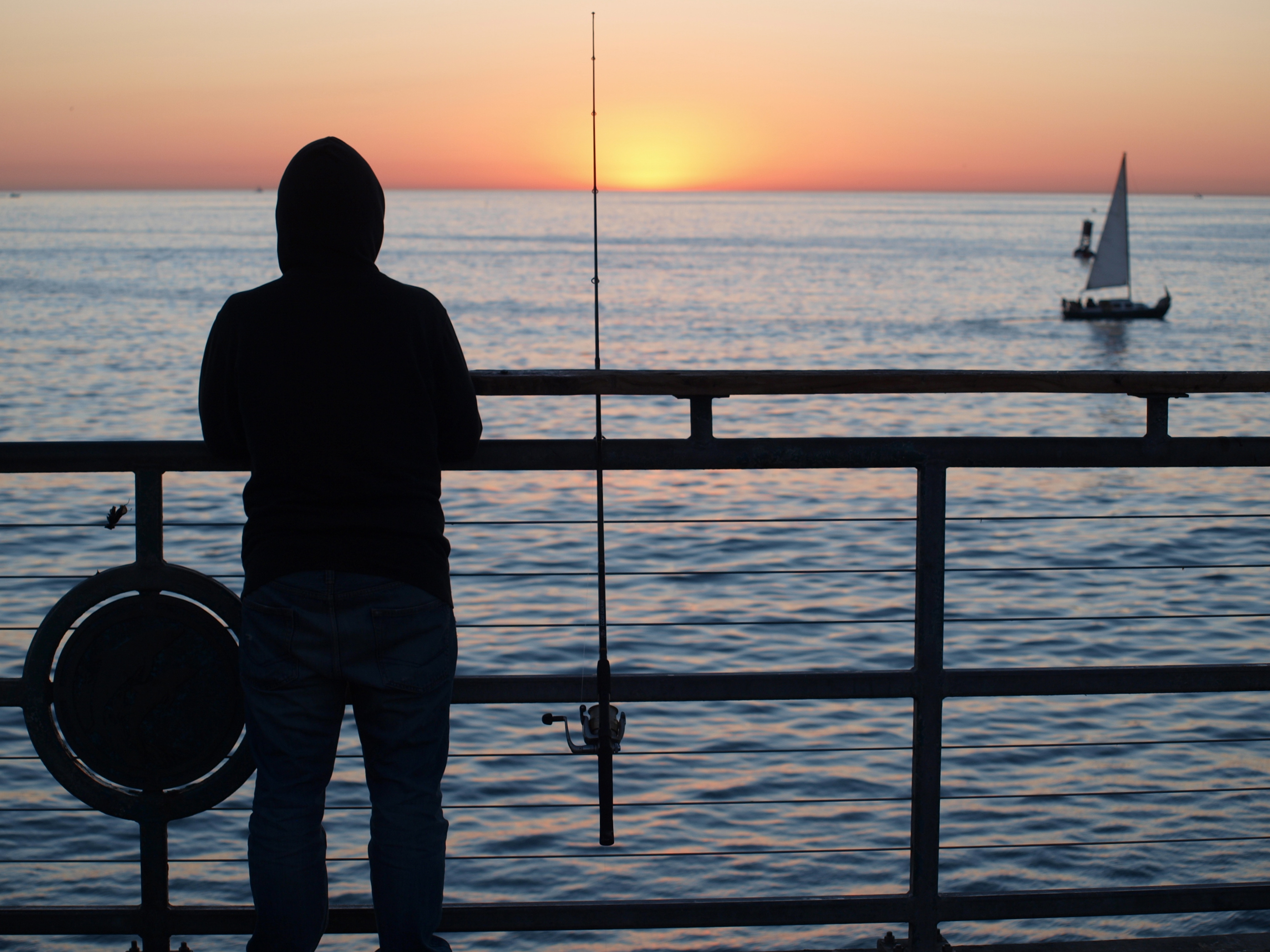
Connected to the Municipal Pier on the south end is the smaller 300-foot-long Monstad Pier, a pier dating back to the 1926. Initially the pier was a private “fishing pier” reserved for pier anglers and those using the boats of the Monstad Sportfishing fleet. However, it wasn’t long until the Monstad’s began allowing other businesses onto the pier, i.e., fresh fish markets and bait and tackle shops (like the ‘50s Fisherman’s Haven). Today, the outer side of the pier is reserved for fishing while the inner side mainly contains restaurants (including the Redondo Café & Bait Shop).
Of note is that while most of the pier’s surface is concrete, the Monstad section has somewhat rough wooden planks in tribute to the original Monstad Pier; the planks can be a little hard on those in wheelchairs.
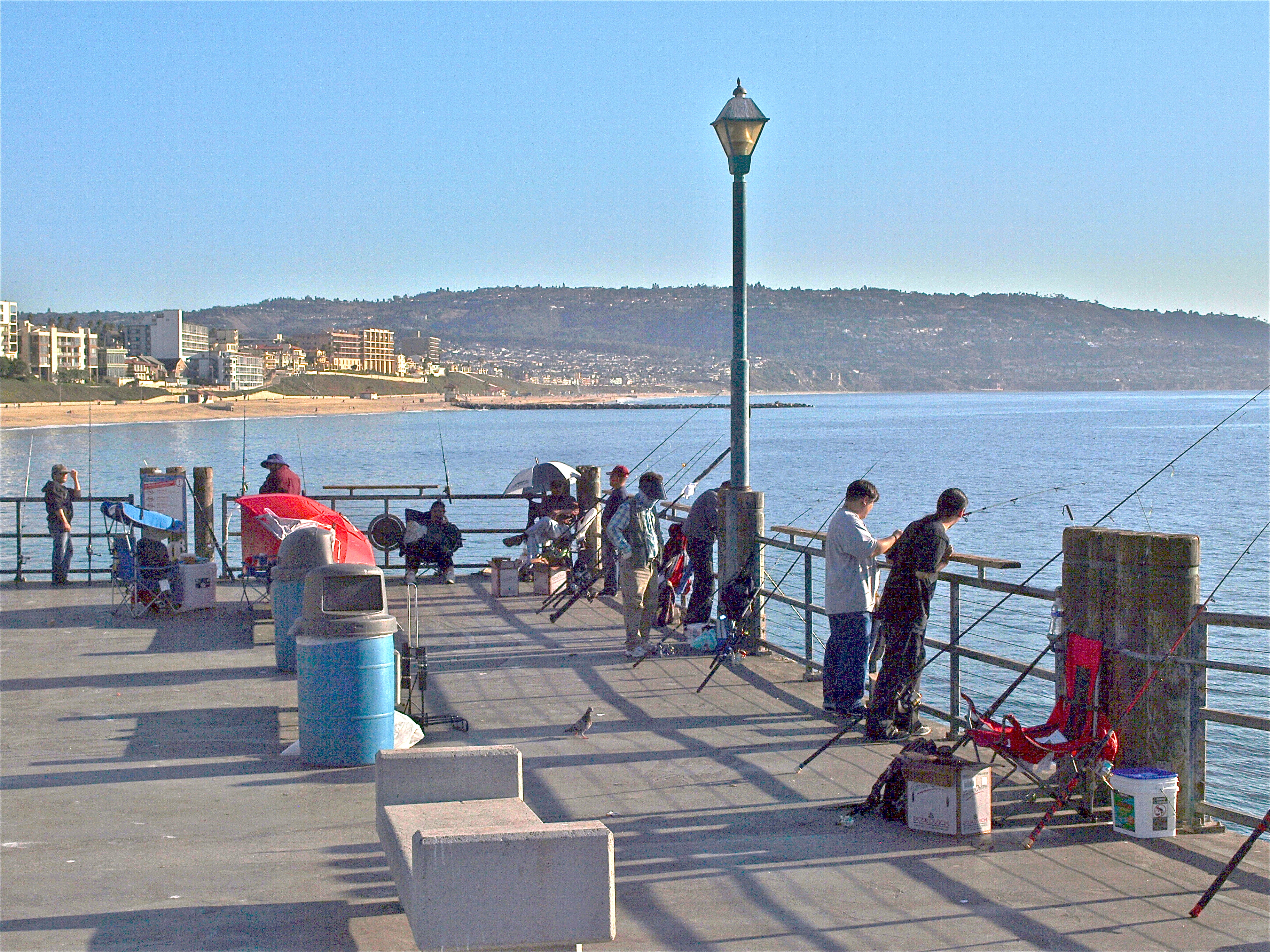
The southwest corner is the “hot” spot for mackerel
In March of 1964 one additional name was added to the mix. It was announced that the city councilmen and the merchants on the pier had agreed that the pier should have one name, preferably Fisherman’s Wharf. Today all of the pier businesses still carry a Fisherman’s Wharf address. For many, myself included, the name muddies the water. You have a name like “Redondo Pier” or “Ol’ Dondo Pier” that can be trademarked and promoted versus “Fisherman’s Wharf” which, to most people, brings visions of San Francisco or Monterey.
The pier is big and you can expect a crowd on most days. A survey released in 1990 by the California Fish and Game Department reported that the Redondo Beach Pier was the highest visited pier in the state with an estimated 4 million visitors a year. Ranking next in order were the Santa Cruz Wharf at 3.5-4 million, Santa Monica Pier at 2.5-3 million, Stearns Wharf in Santa Barbara at 1.6 million, and Fisherman’s Wharf in Monterey at 1.5 million.
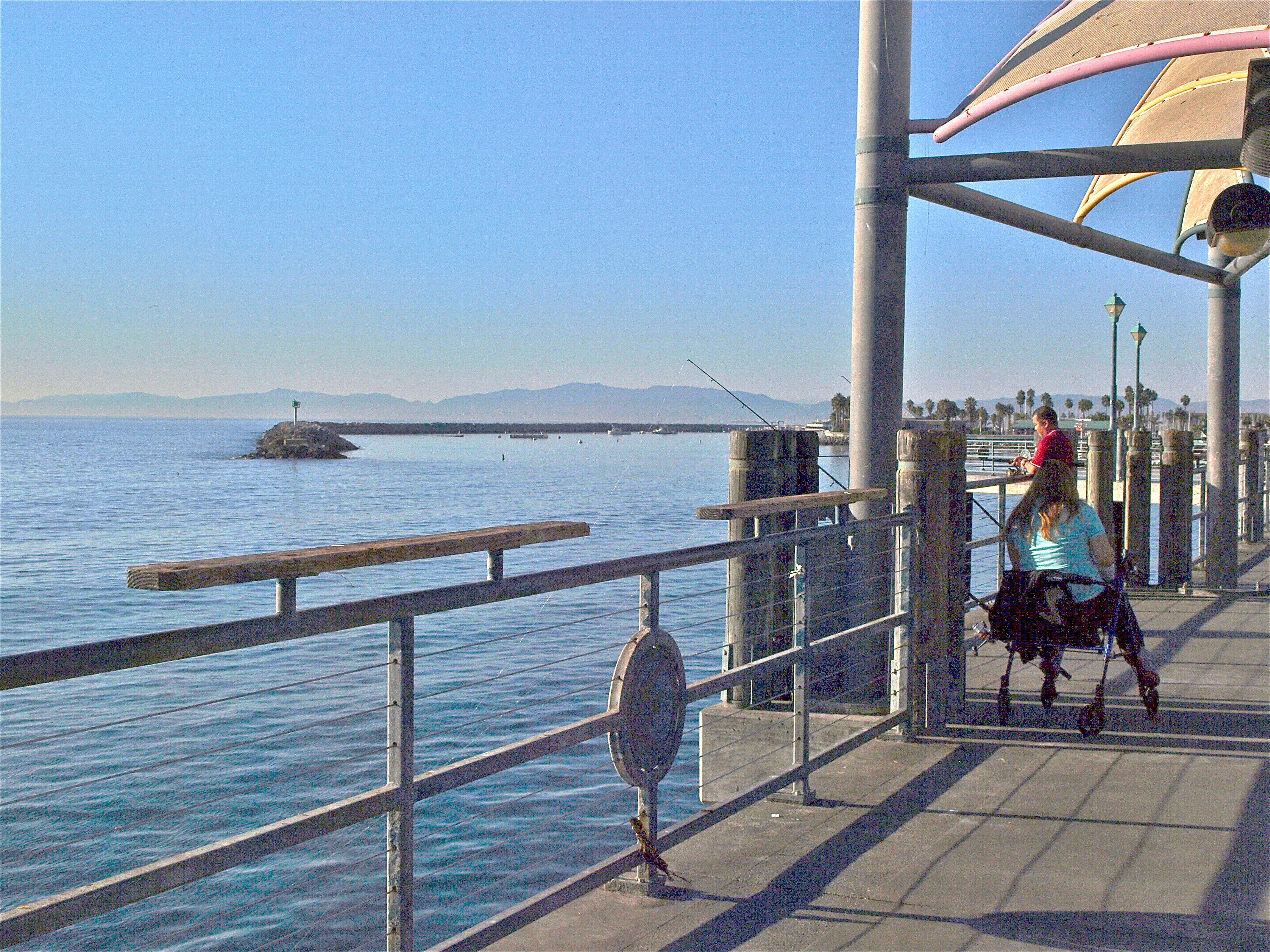
A common denominator is that each is a large multi-use wharf/pier that contain a variety of attractions—restaurants, shops and in some cases amusement areas. The highest fishing only pier was Pismo Beach at 1.5 million (although I am confident that the Oceanside Pier would have exceeded that figure if it had not been closed and under reconstruction during the survey). The fishing crowd is huge at Redondo but as at the other multi-use piers anglers are only part of the mix.
In fact, one of the main attractions of the pier is simply its diverse, eclectic nature. There are numerous restaurants, many ethnic in nature, as well as an “International Boardwalk” filled with a number of different shops. There is also an unending mix of different nationalities and whole families camped out on the pier. The mix of restaurants, shops, and games on the arcade makes it a great family venue while the ample parking makes it an easy destination.
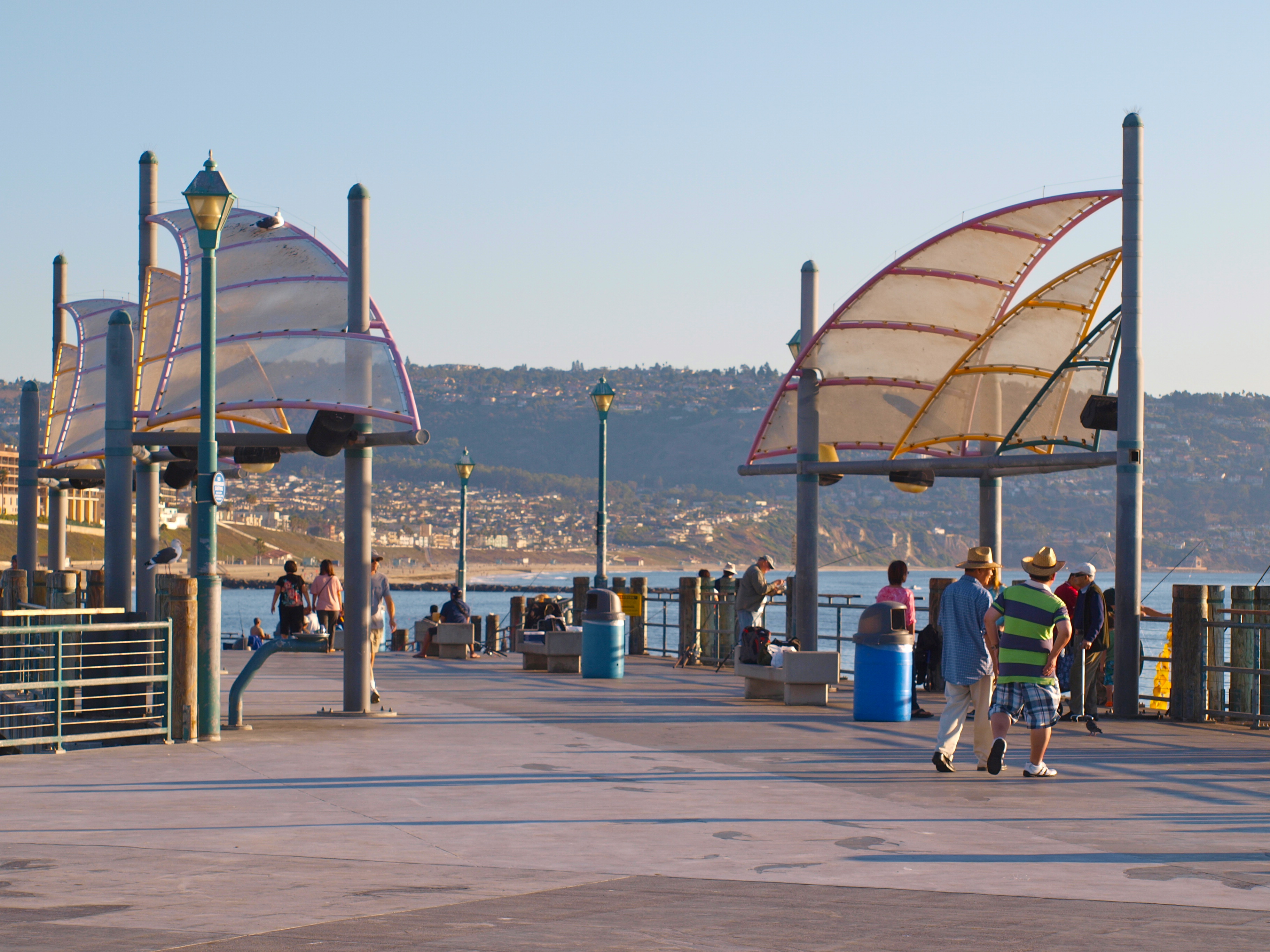
Some sections of the pier have an almost Coney Island-like feel to them (or perhaps a county fair feel). Window after window are filled with the specialties of the place, lots of fried food specialties (mainly seafood), giant corn dogs, corn-on-the-cob, funnel cake, hot dogs, hamburgers, pizza and a lot of churros.
And then there are the windows filled with ethnic dishes. If you like Asian food, it’s here (mainly Japanese and Korean) and sushi is always an option as well as red bean pancakes. One Yelp review suggesting trying a Korean seafood restaurant and some “Maeuntang (spicy fish soup) that goes perfect with some sashimi or crab and the bottles of soju.”
Mexican food? Of course, including a nice El Torito restaurant overlooking the sea.
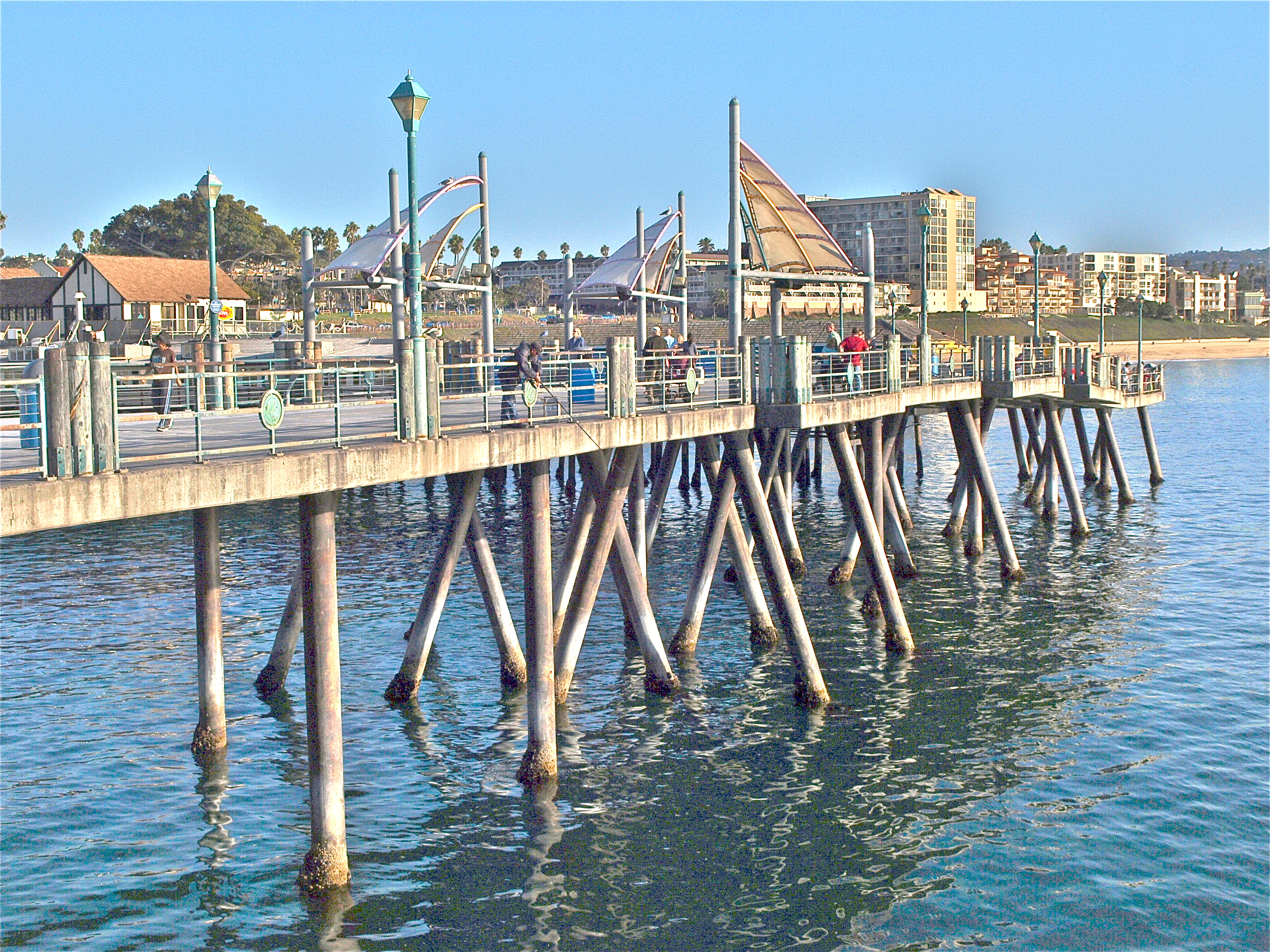
For anglers, the fish markets filled with a mix of seafood, everything from fish to crabs, lobsters, scallops, shrimp, mussels, sea urchins and more, are always interesting and those craving seafood should have no problem finding something they like. I’m always ready for some fresh steamed cracked crab?
On Yelp one day someone mentioned that the pier had a feel of “a flea market in Fresno.” Not exactly sure what that means but someone responded: “That is true. You can tell that the pier is not a clean and ritzy place for the Manhattan, Hermosa, and Redondo residents. It is more of a place for families in Lawndale and Hawthorne that want to spend a day at the beach. That isn’t necessarily a bad thing.”
Agreed, it may not be the place for the local “hotty toddy” crowd. No, this is a pier for the hoi polloi—the common people. And for the “pier rats,” the hoi polloi of the angling world.
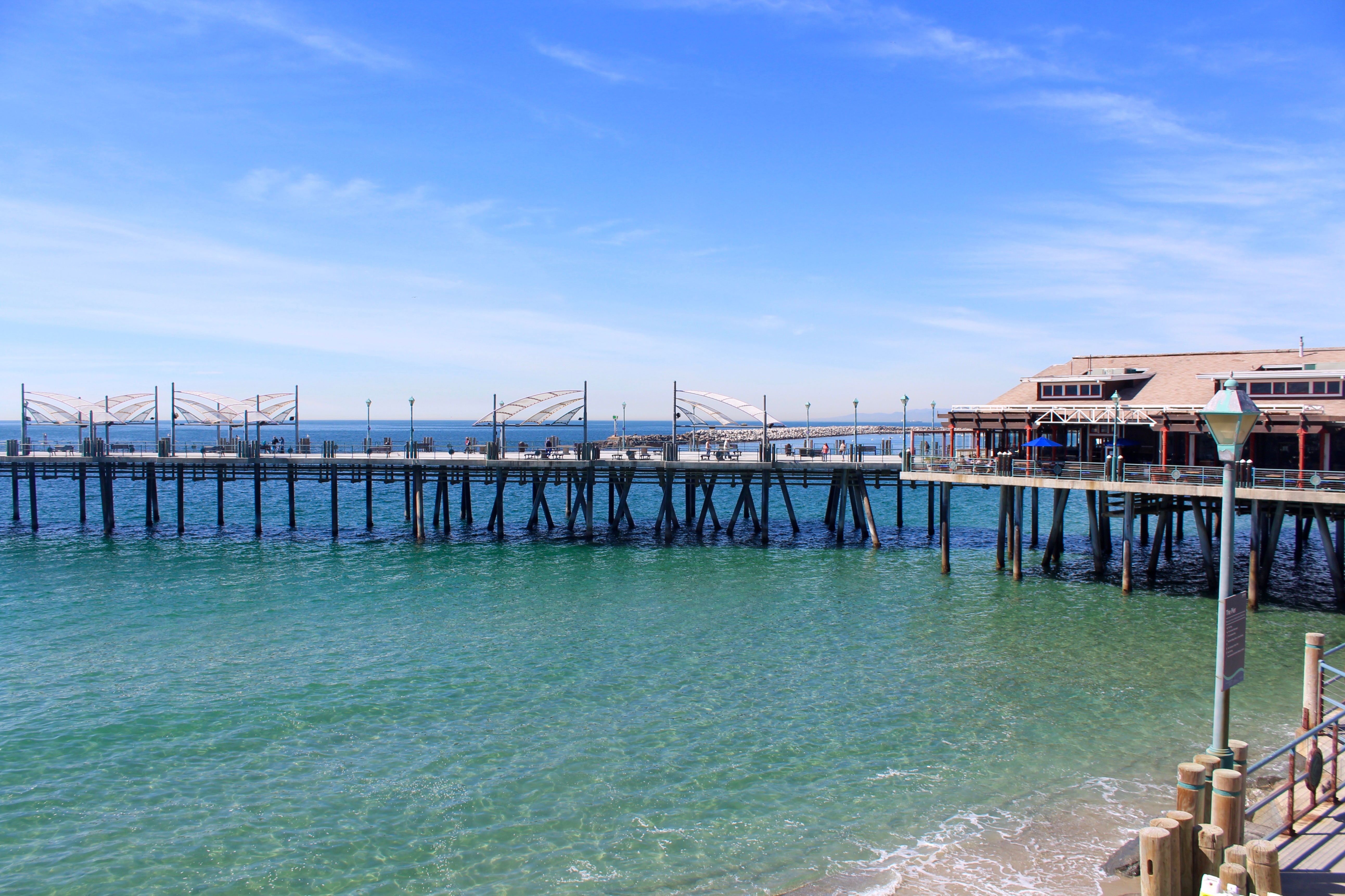
Did someone mention crowds? Sometimes you have to watch out for the sheer number of people on the pier. Anglers rolling pier carts and their rods down the walkway, mothers with baby carts, so called power walkers, rollerbladers, cyclists (who have their own lanes but don’t always stay in them), skateboarders (who are usually closely watched), and people more interested in checking their cell phones than in watching what is ahead of them. You sometimes need to be a “defensive walker” on a crowded weekend.
The pier complex is not perfect for everyone but it is fun for most people, a fact which seems somewhat amazing given today’s “judgment a second” social media that seems to generate more negative review than positive.
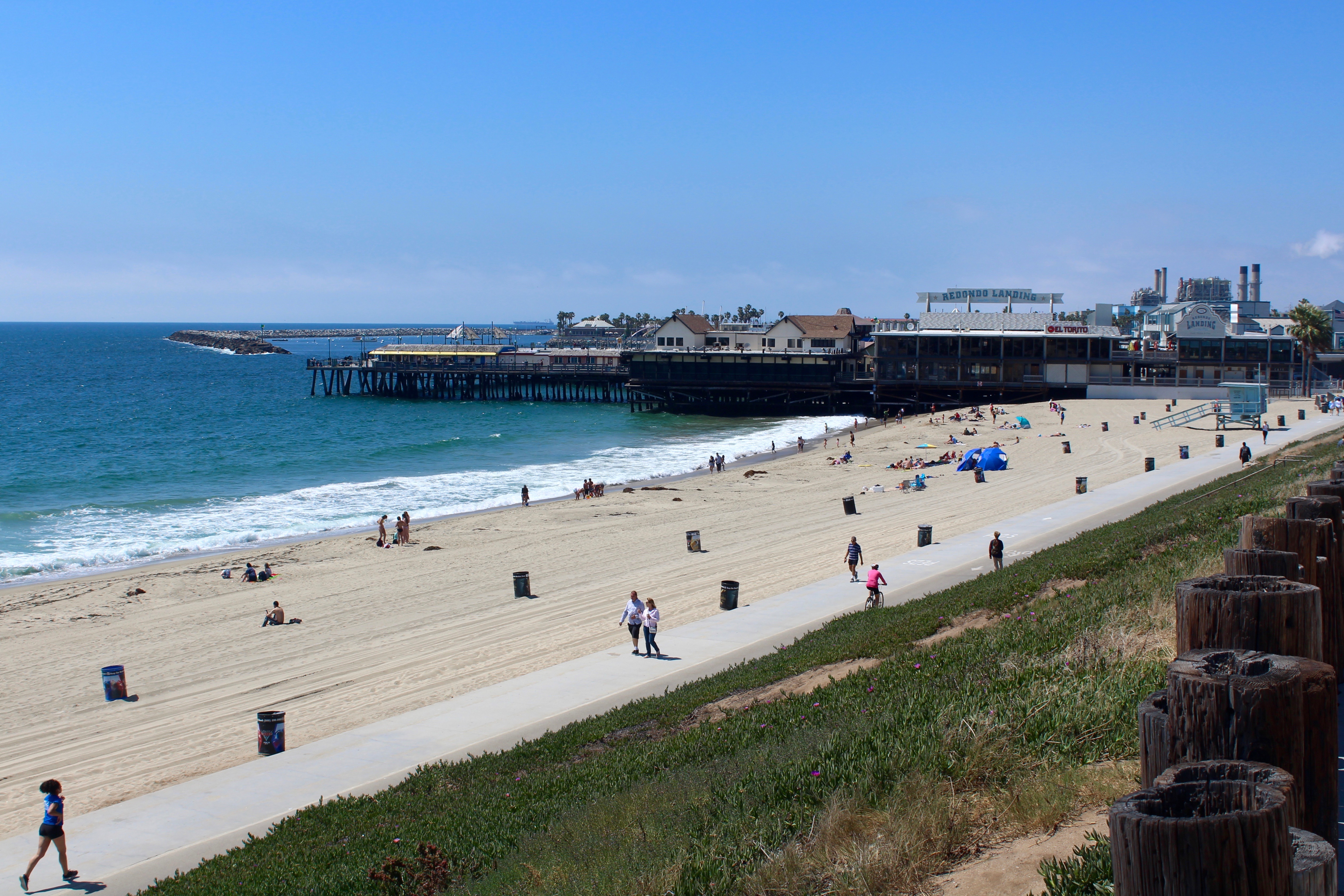
The Municipal Pier itself is listed at 1,550-foot-long but because of its horseshoe shape it actually does not reach that far out into the water and has the feel of a shorter pier. It sits fairly high off the water, 25 feet, but it’s a small price to pay for protection from winter surf.
Although the wide and sandy Redondo State Beach begins just at the base of the Monstad Pier (and heads south), little in the way of a sandy beach environment is presented to anglers. Here most of the beach is hidden under the complex of shops on the pier and angling for the shallow-water surf fish like croakers and perch is generally only fair. The exception is the Monstad Pier section where anglers can fish from fairly shallow to moderately deep water. The mid-depth water holds most of the halibut and helps explain why the Monstad Pier was long considered a premier pier for halibut.
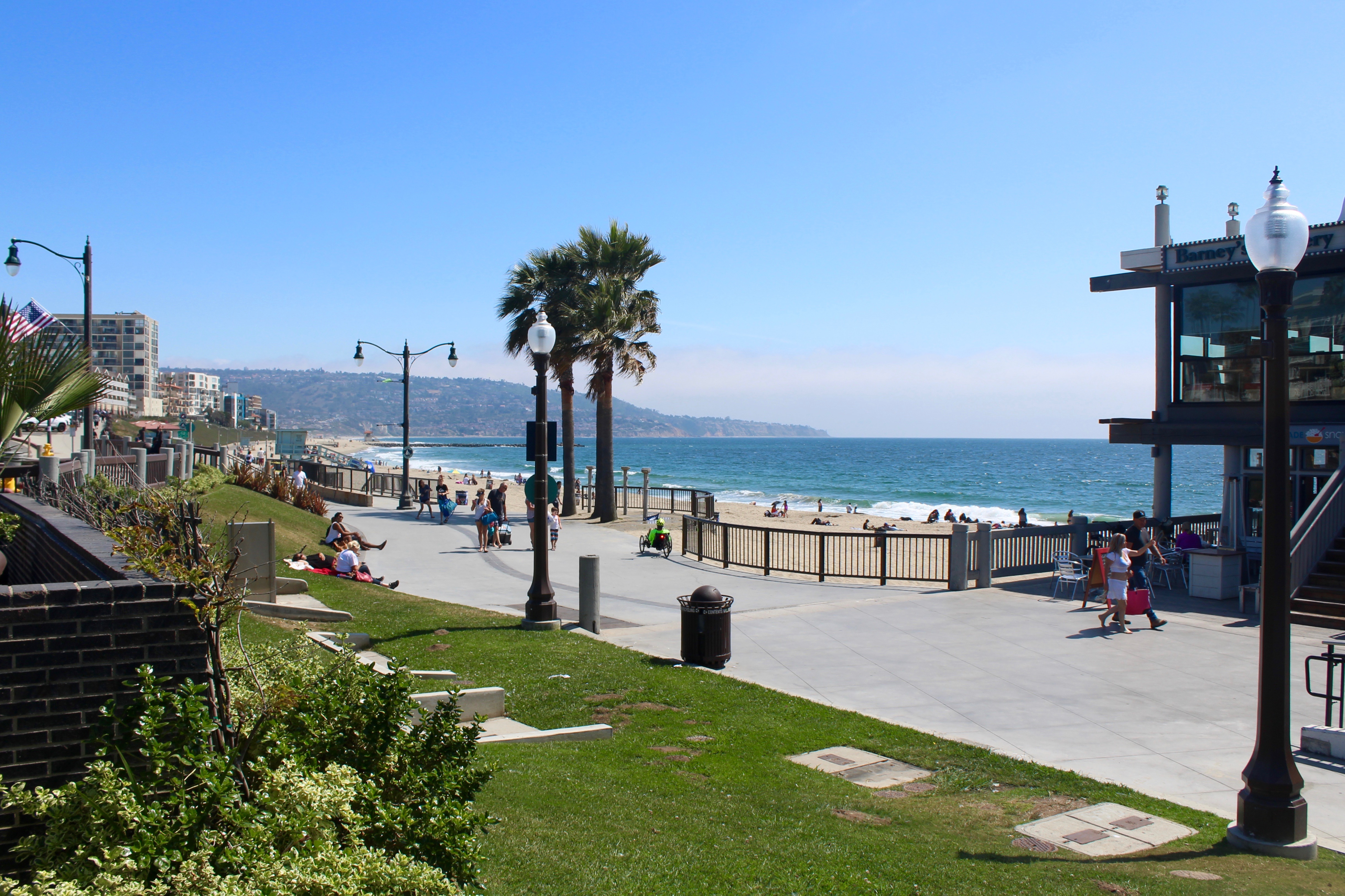
The pier itself is not only a beautiful pier but also one of the best-designed piers, from an angler’s viewpoint, that I have seen. Especially thoughtful are the bait cutting platforms located every few feet along the railing. Now, if someone from Huntington Beach would just pay a visit! Something added in the past decade was a larger fish cleaning station, one in which the scraps are sent to the sewer instead of into the ocean. The fishing isn’t as good but it does serve the 21st century requirements imposed by the state (as if fish and crabs are not going to eat cut-up pieces of fish).
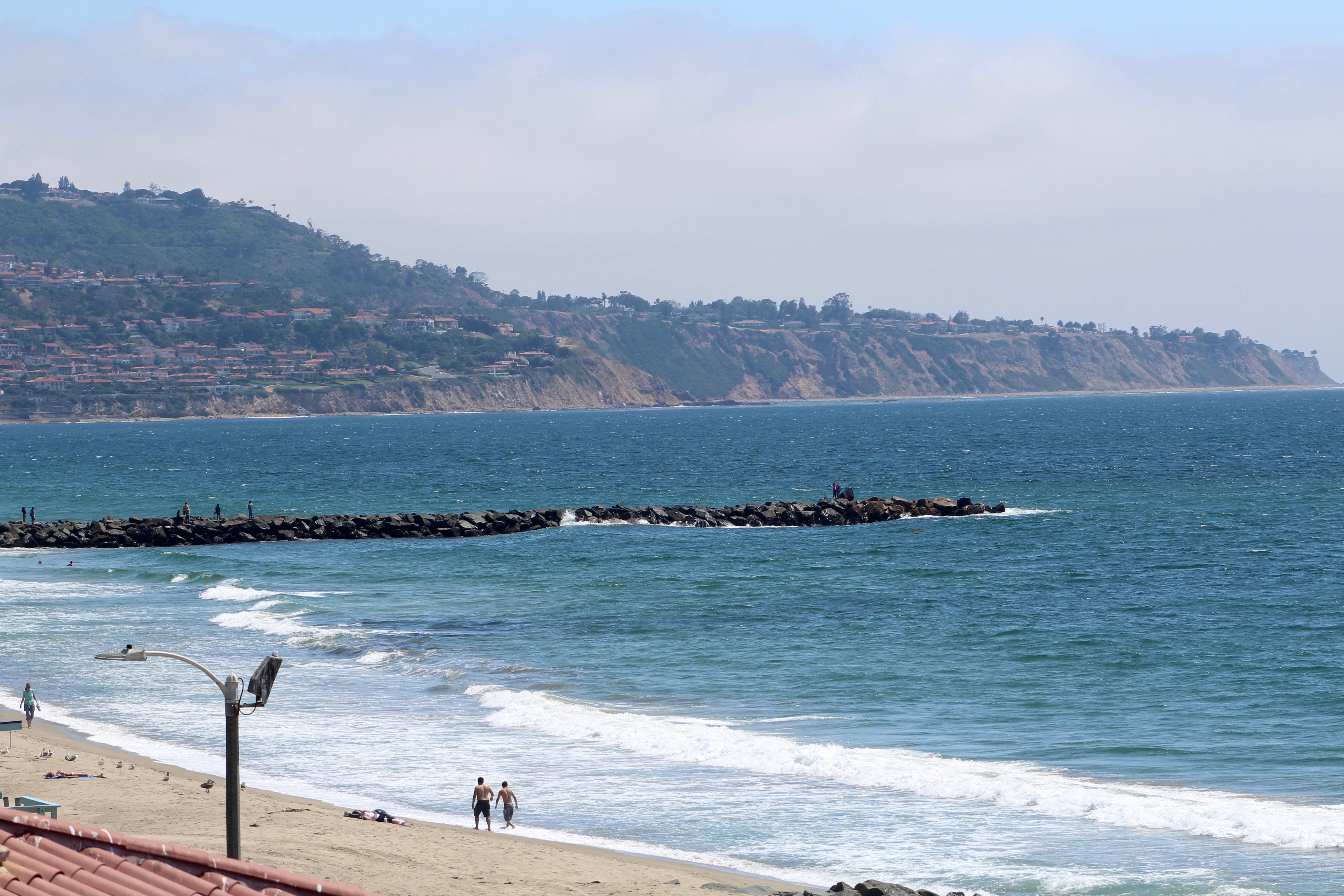
Environment and fish. What distinguishes Redondo from most other piers is the deep-water Redondo Submarine Canyon that curves in fairly close to the pier. The end area itself offers exposure to this water. Pelagics such as Pacific mackerel can be thick and indeed the pier is probably the top “mac” pier in the L.A. region, producing mackerel when sparse elsewhere. The macs are joined by jack mackerel (Spanish mackerel), jacksmelt, and sardines (some years); at times, the water will be unbelievably thick with several different species.
The good news is that the smaller baitfish (aka food) can attract larger game fish such as barracuda (generally at night) and yellowtail (generally late summer to fall), especially in El Niño warm-water years. The pier may also be the top “bonito” pier in the area during warm-water years although the nearby Redondo Sportfishing Pier may see a greater fish per angler average.
Decent-sized sharks, guitarfish and bat rays are also fairly common.
Due to the deep water in the canyon, the pier also at times yields an unusual variety of fish including occasional catches of deep-water fish like hake, sablefish, sanddab and cusk-eels.
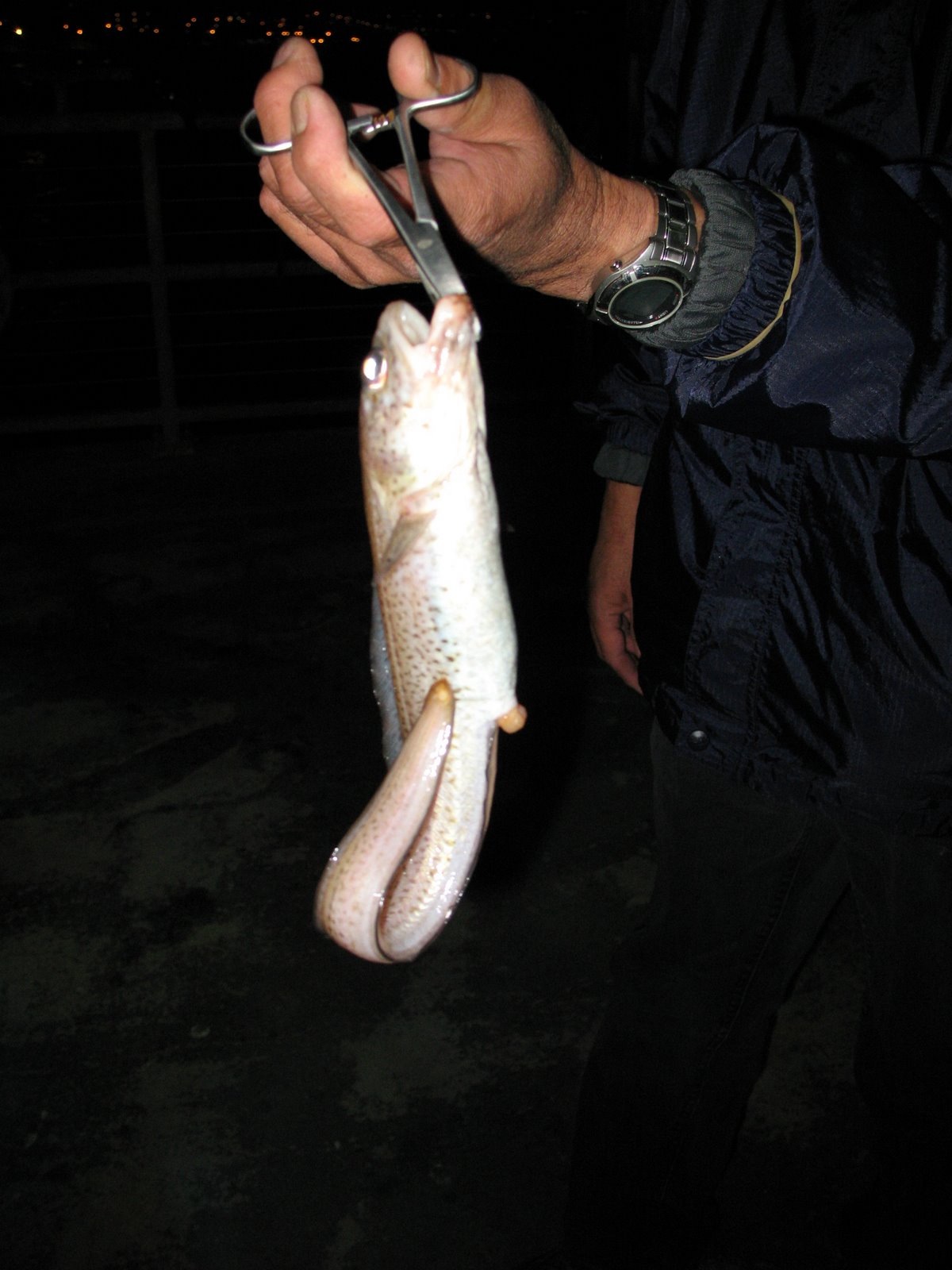
Cusk-eel
Sushiman, a regular on the PFIC Message board commented in 2007, “Redondo is certainly one of the most intriguing piers around for it’s sheer amusement value. It kicks out a good variation of fish as well. Just this past month, I saw a triggerfish, a Humboldt squid, a 45-inch halibut, and a black seabass caught on this pier. The occasional ‘cuda attack is also fun as well.”
His reference to triggerfish, a fish more common to Baja, was interesting since an early F&G record for triggerfish concerned two finescale triggerfish (Balistes polylepis) taken from the pier in June of 1951. Several more triggerfish have been reported to the PFIC Message Board.
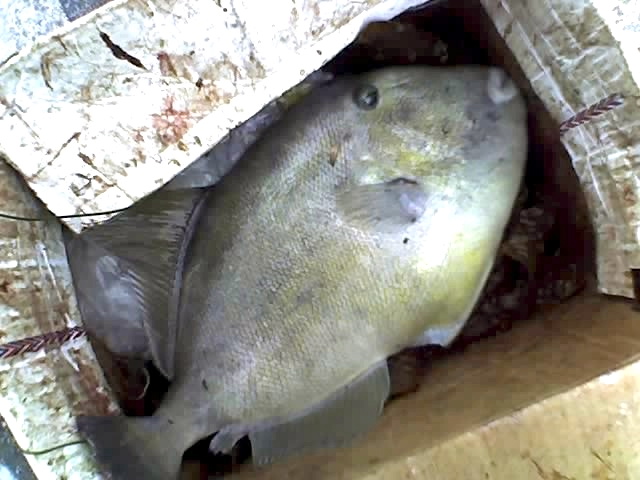
Finescale triggerfish
The pier also occasionally sees species more common to northern waters. Several years have seen striped bass taken from the pier (see the Message Board posts below). The first report was of an 18-pound striper in June of 1954 while a 30-pound striper was taken in December of 2001. An 18-pound silver salmon was caught in May 1940 while a 25-pound silver salmon was taken in June 1956.
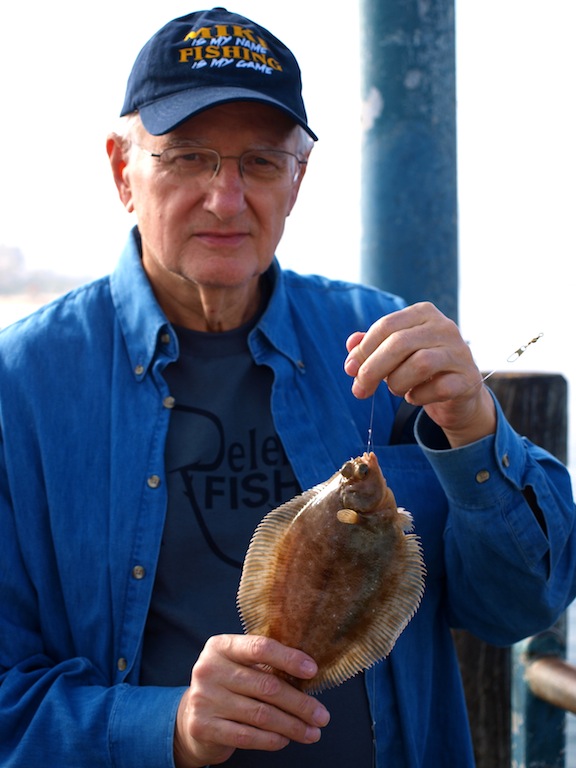
Not rare, but a nice change of pace at the pier, was a small C-O sole (aka C-O turbot) that was taken by my friend Mike Granat in March of 2015. We weren’t sure what it was at first although I thought it was a turbot. A check with Fish and Wildlife confirmed the identity.
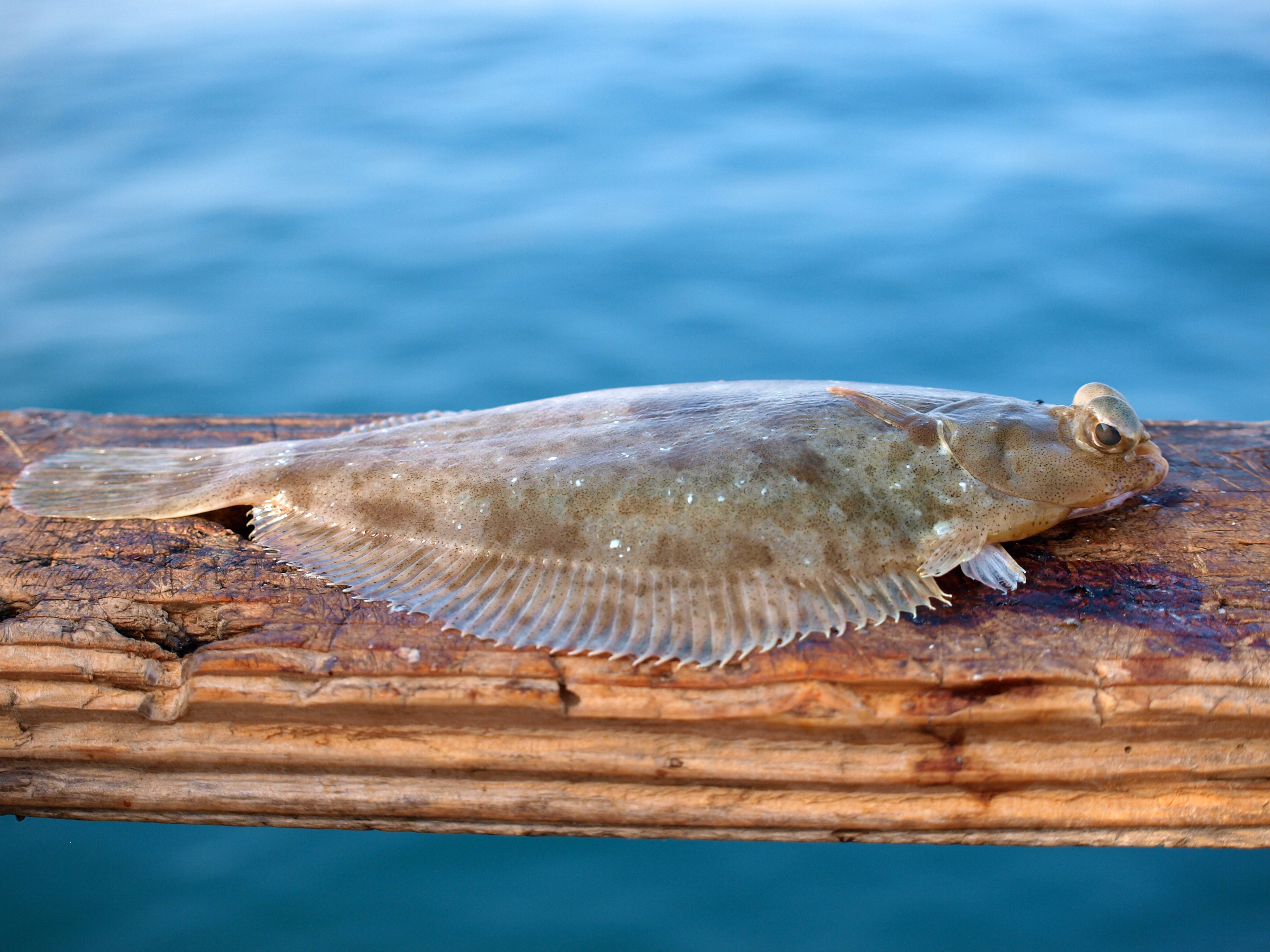
A fish that was indeed rare was one recorded by the Fish and Game Department more than 50 years ago. “A Paloma pompano (Trachinotus paitensis) (500 mm. total length and weighing 1,655 grams was caught on hook and line in the surf at Redondo Beach on November 18, 1959.”
Mac pier! Surveys done by the California Department of Fish and Game from 2004-2009 showed Pacific mackerel as the main fish at the pier year in and year out. The survey recorded 1453 mackerel while the second highest number for a species was Pacific sardine with 467, nearly a thousand fish less than the mackerel. The mackerel ranked first every year while the Pacific sardine ranked second in 2004 and 2005 but then were not seen in the survey the rest of the years. Such is marine biology. Mackerel though have been a reliable species at the pier for over 125 years.
The surveys didn’t reveal much in the way of species, only 17 in all. Ranked numerically — Pacific mackerel, Pacific sardine, shiner perch, jacksmelt, Pacific bonito, jack mackerel, topsmelt, walleye surfperch, California halibut, California barracuda, pile perch, senorita, shovelnose guitarfish, leopard shark, yellowfin croaker, white croaker and white seaperch.
My personal fishing records for the pier show only a 5.91 fish per hour average and 9.79 points per hour average (a ranking based on number and size). Both figure are in the middle when compared to the the other piers in Santa Monica Bay—Hermosa Beach, Manhattan Beach, Venice and Santa Monica. It’s hard to say why my numbers aren’t a little higher although many of my trips have been off-season trips including a skunk—no fish, in a December visit in 2002. However, part of the problem is one that is common at many of the deep-water piers: it’s great when the pelagic species are present but can be slow at other time. Bonito are often present in warm water years and can disappear for years during a cold water cycle; the same for sardines whose numbers go up and down for several reasons.
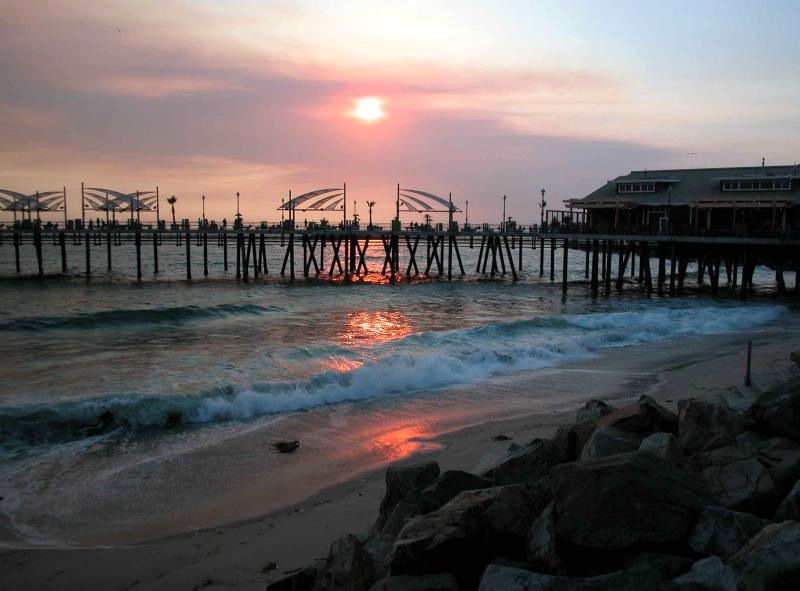
Fishing Tips. Ninety percent of the time when I call the Redondo Café & Bait Shop for my monthly fishing report I am told, “it’s the same old thing—mainly mackerel.” And night after night, the pier will be loaded with people seeking out the mackerel. Given the proclivity for the macs it might seem natural to simply target them when visiting the pier.
However, I always suggest bringing two set-ups, one for the top water fish, i.e., mackerel and bonito, and one for the bottom fish, i.e., halibut and croaker.The Redondo Pier is a large pier and its horseshoe shape and adjoined Monstad Pier area present a variety of environments from which to fish. Newcomers seem to head straight to the end, a trait common at most piers, but the regulars know better. Different fish are located at different depths and like different bottom conditions. Knowledgeable anglers always study the pier and, depending upon the species they are seeking, fish the environment known for their fish.
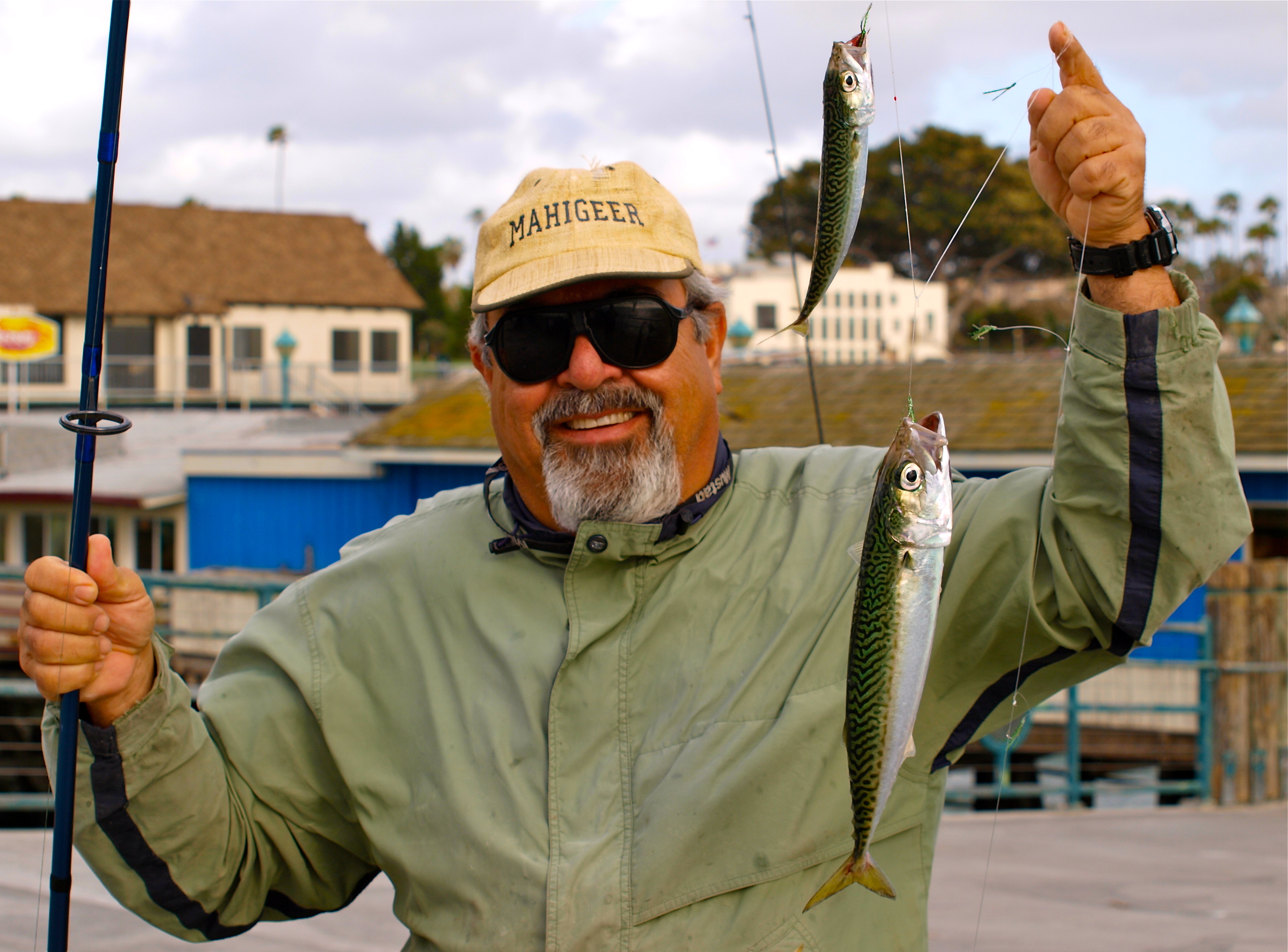
Mahigeer (Hashem Nahid) and the mainstay fish of the pier — Pacific mackerel
Most SoCal piers show a sandy, shallow-water surf area with surf species predominating in that area. They have a mid-pier, mid-depth area that presents some of the inshore species and an overlap with the deeper water fish. Next is the end area where most of the pelagic species and larger sharks and rays (sharays) are caught. Lastly is the piling areas themselves, which attract their own mix of fish. Each area calls for its own type of baits and riggings. Here, because of the shape of the pier and structures (like restaurants) built on the pier it’s a little harder to know where to fish.
One day I asked Mahigeer (Hashem Nahid), an excellent angler and a regular at the pier, what he considered the best spots. He said there were three “primo” areas. His first choice was “the area across from where the bathrooms and seafood restaurant sits.” This is the Monstad area of halibut fame and when the tides are right it can be elbow-to-elbow fishing. And, with lights available, the regulars will be found fishing the area day and night.
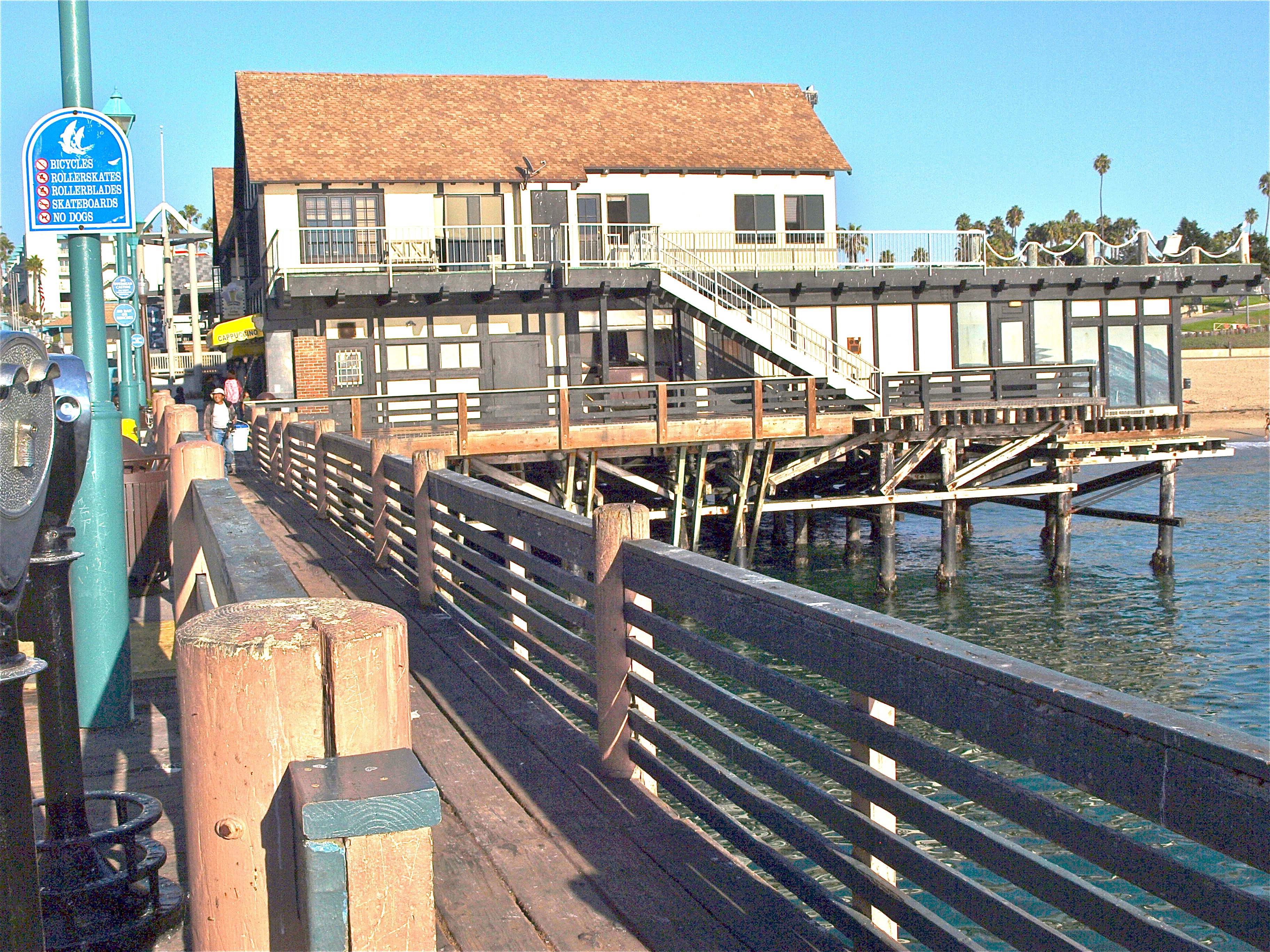
The Monstad section
But there’s more than just the Monstad area—or the end railings. According to Hashem, “a second area is the surf area located between Kincaid’s Restaurant and the north walkway to the pier.” The area can’t be fished from the beach but is accessible to anglers casting from the pier toward the beach.“
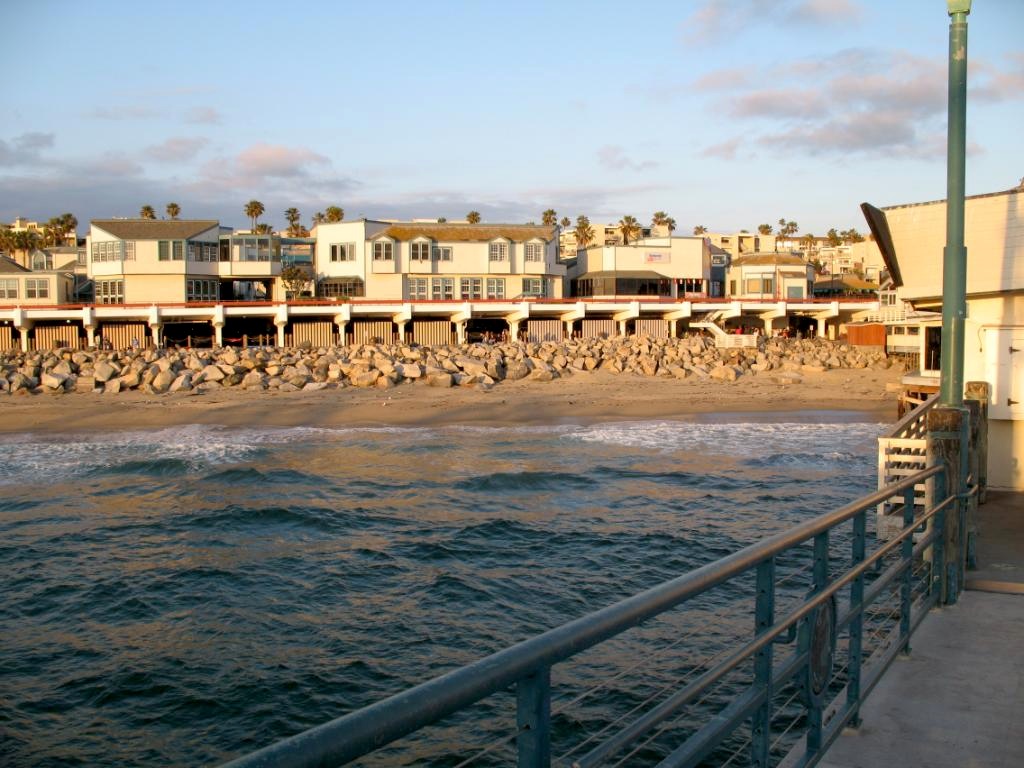
The walkway section
“The third and least fished area is between the north walkway and the south walkway. From personal experience, I know that the latter areas can yield up some decent croakers as well as halibut (but few people seem to fish in those areas).”
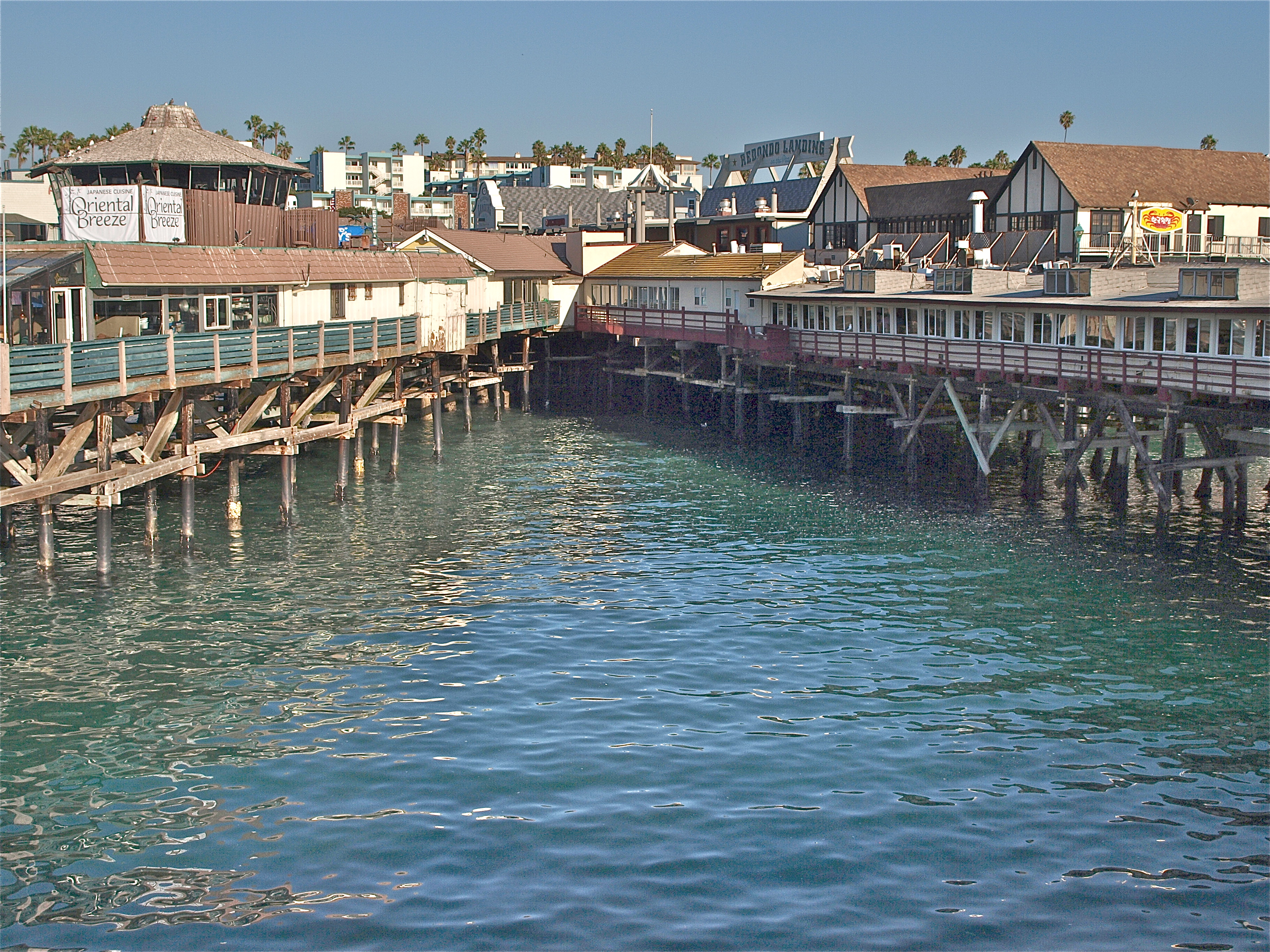
Inner section
I might add that I too have caught several nice yellowfin croakers while fishing the early evening hours in the inner section of the horseshoe pier, and surprisingly these were caught on cut anchovy. Although most anglers seem to want to automatically fish the deepest water and cast out from the outer railings, don’t be afraid to try the inner waters.
Pelagic species—mackerel, jack mackerel, jacksmelt, sardine, bonito, barracuda and yellowtail. For the mackerel, fish the Monstad section or the end railings. Use a Sabiki or similar-type bait rig or use bait—pieces of mackerel (or strips of squid) and fish the mid-depth area. Typically the mackerel hit best early morning or in the evening (till sometimes late at night) and when the macs are running the railing is lined with anglers and the sea is aglow with different colored glow lights. During a “mac attack,” it’s common for people using bait rigs to catch 4-5 mackerel at a time and anglers will be keeping bucket after bucket of mackerel.
By the way, Fishing for mackerel at night on the wharf isn’t exactly a new idea as seen in the following:
Moonlight mackerel fishing is all the craze in Redondo now. Scores of anglers, with rod and line, may be found upon the wharf from twilight till midnight landing the beautiful shiny fish.
—Los Angeles Times, June 30, 1893
One trip saw a lady standing next to me with two Sabiki rigs tied end to end on her line. The eight foot long or so rig was almost impossible for her to cast (especially since you are supposed to use underhand casts) and she nearly hooked several people. Luckily, she finally snagged her rig on the piling (which made her boyfriend very unhappy) and things became a little less chaotic. I’m still not sure why she would have needed a dozen or so mackerel at a time? The question is are all those fish really going to be used for food? Fertilizer? Who knows?
Anglers using bait rigs may also encounter schools of jacksmelt, sardines or jack mackerel. They’re usually in the same mid-depth or upper-water levels and again big numbers can easily be caught. The only difference is that usually smaller size hooks should be used. As with the mackerel, there are no limits but how many do you really need to keep?
When the hard fighting bonito make a showing the pier will again be jammed with anglers! The bonito, mostly in the 1-3 pound class but occasionally including some large 4-6+ pound fish, generally hit during the day (especially at dawn and dusk) and two main techniques are used for the hard fighting boneheads—live bait or artificial lures.
Live bait (anchovies or sardines) can be great if you can get them. If not too crowded, try live bait under a split-shot sinker. However, here it is often way too crowded for that approach. A second live bait option is to slide a live bait leader down your line using a snap-swivel and about a 2-3 foot leader with a live bait hook.
Most bonito though are caught on lures and historically most have been caught on splasher-type rigs—a Cast-a-Bubble, a wooden “bonito egg,” or a golf ball, with a feather trailing behind a 3-4 foot leader. Feathers come in several colors but green and white or green and yellow seem to be the favored colors.
Spoons like Kastmasters, Krocodiles, and Megabaits have also become increasingly popular for the boneheads. A few friends who have fished up north have also had luck using Crippled Herring and Buzz Bombs. I think the main idea is to make commotion at the top and the lure looks like a fish fleeing the commotion.
At times, the bonito will be micro-sized young ‘uns and they’re perhaps not quite as sharp as their elders. They will hit Sabiki and similar-type bait rigs, often several at a time. But why, since you are limited to five small bonito (in the overall limit), use a bait rig? One cast might yield your limit. It’s clear though that when the bonito are running too many people will be keeping too many fish. Poaching is alive and well at Redondo!
When barracuda show up be ready with some gold or silver-colored Krocodile or Kastmaster spoons (although MegaBaits and Rebel Fast Tracks are increasingly popular).
Yellowtail are the trophy fish. Their appearance can quickly galvanize the pier rats into a state of apoplexy. Pier rats are soon tossing out whatever metal creations happen to be found in their tackle boxes, hoping to lure the ‘tails into their coveted section of water. The yellows for their part usually show just enough ‘tail to entice and tease the excited anglers. Then they disappear. Still it is fun while it lasts and adequate numbers are caught most years to keep the hope alive.
Several methods are time proven for yellowtail: (1) Live bait, a still lively Spanish mackerel (jack mackerel) or Pacific mackerel (small) that you’ve caught with a bait rig. Use a sliding leader or a leader with a float. (2) A leadhead jig that has a strip of mackerel 1 1/2 inches long by 1/2 inch wide attached to the hook. (3) Artificial lures such as Crippled Anchovies, MegaBaits, Rebel Fast Tracks and Buzz Bombs.
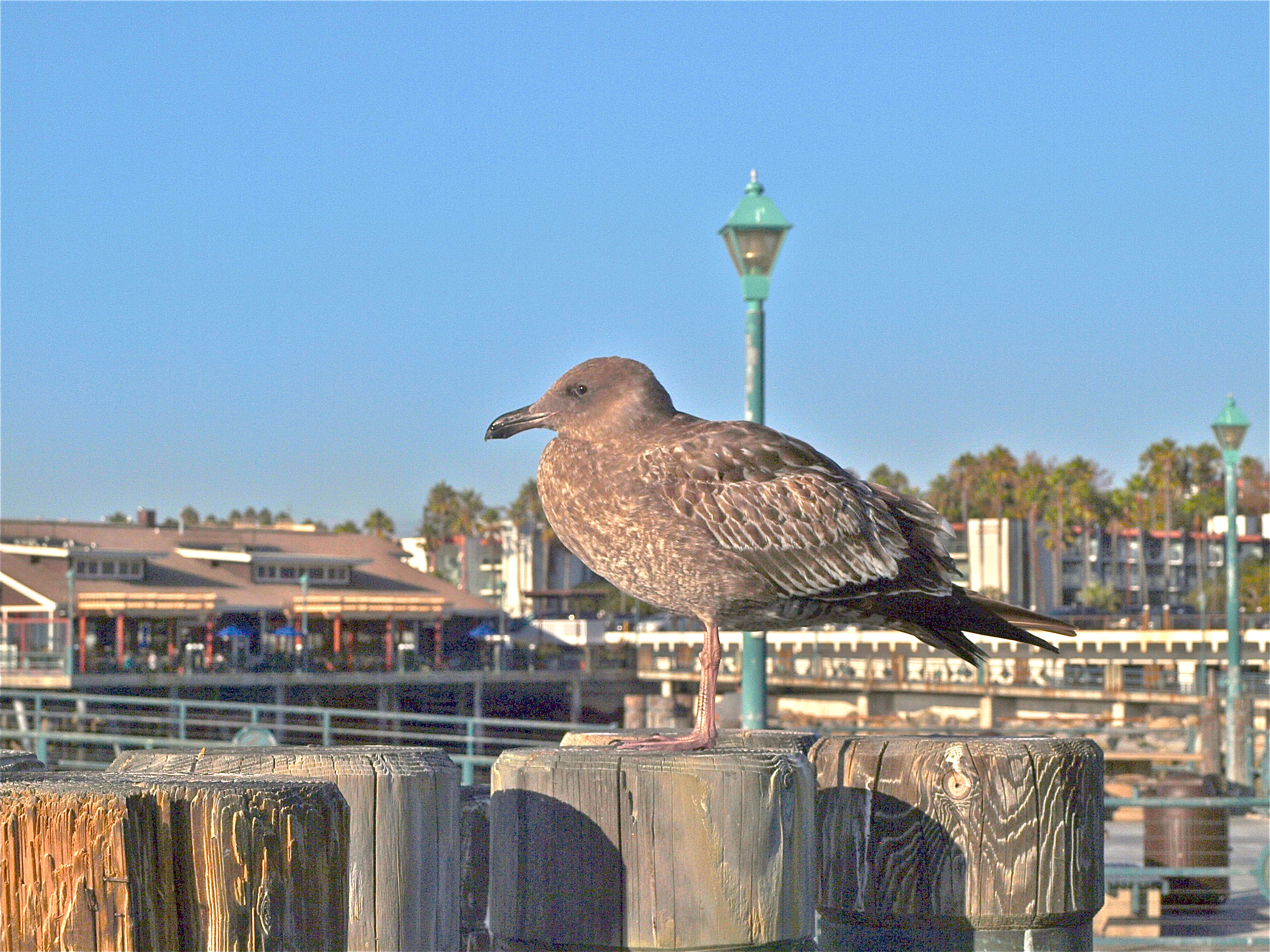
Sharays. Nighttime is often the best time for mackerel and is almost always the best time for a variety of sharks and rays. The sharay fraternity typically includes several medium-sized sharks and rays—leopard sharks, gray smoothounds, spiny dogfish, thornback rays, shovelnose sharks (guitarfish), and bat rays. Less commonly caught, but still a possibility, are horn sharks and swell sharks.
Of course there are also the big sharks and rays. Thresher sharks and 7-gill sharks can top a hundred pounds and are fairly common as well as the really big bat rays (always an old mama bat ray). Blue sharks wander in from deeper waters about once in a blue moon and I’ve have been told, but can’t verify, that both hammerhead sharks and mako (bonito) sharks have been landed at the pier.
Best bait for most sharks is a bloody fillet of mackerel or a similar oily fish; if you’re seeking the big ‘uns, a whole live mackerel is hard to beat. The best bait for bay rays is almost always squid.
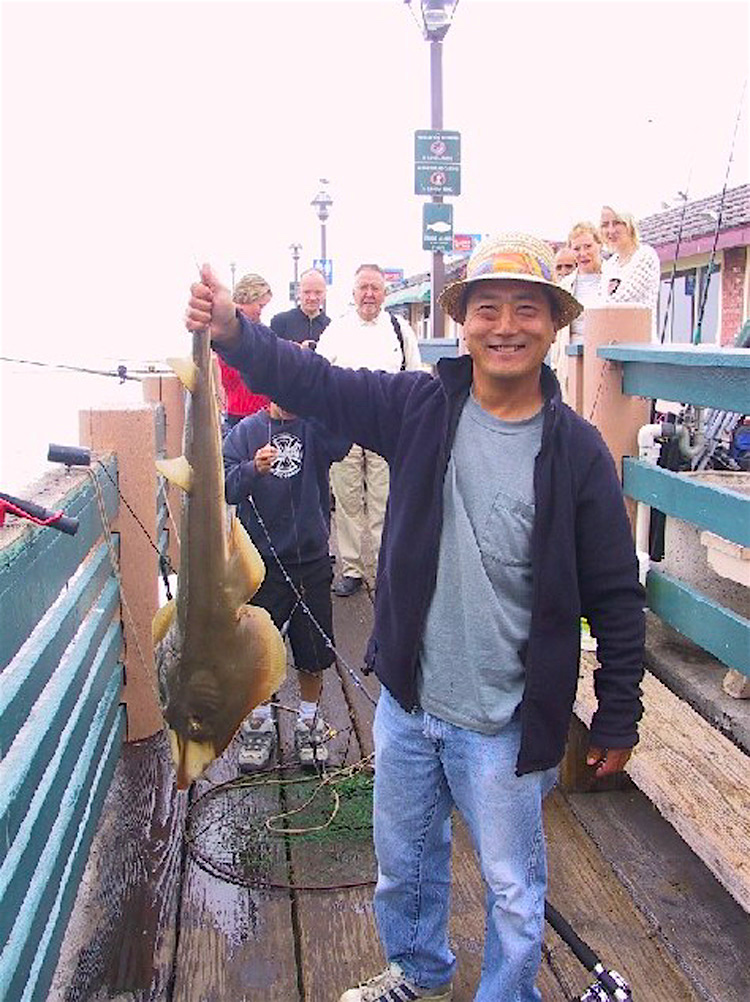
Shovelnose guitarfish
An interesting technique that I first heard about at this pier concerns squid and bat rays. On a Message Board discussion concerning the best techniques for large bat rays, one communicant, YTail Stud, said he used squid and live bait. He said you first catch a small sardine or smelt and then place it in a bucket. Next, using a whole thawed squid, cut an opening in the squid and place the live bait inside the squid body. Hook the live bait through the squid body. The result is a squid that appears to be life-like as it moves about because of the enclosed fish. He recommended using this with a heavy rigging near the breakline on an incoming tide.
Remember to bring a net or a treble hook gaff and strong rope to heft the prize up to the pier. Only use a gaff if you intend to keep the fish!
A shark still fairly rare, but becoming more and more common in the area, are great white sharks. Remember that the great whites are protected and illegal to take. If one is hooked the line should be cut before bringing it up to the pier.
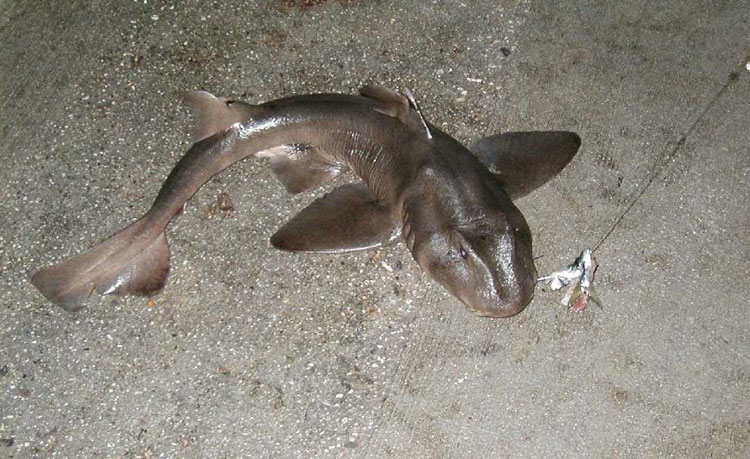
Horn shark
Halibut. Although mackerel are the main fish caught at the pier, the prize catch for most anglers is California halibut. One of the arguments I used to have with a few of my southland pals concerned halibut and the best piers for catching the prize flatties. We tended to agree that Crystal Pier was best in the San Diego area and Goleta Pier was the best in the Santa Barbara area. The argument arose over the Los Angeles-area piers. Some preferred Redondo Beach, some claimed Hermosa was better, and a few gave votes to Seal Beach and Malibu. I voted for Redondo.
At the time my vote was simply a hunch based on a few visits to the pier; I had no data to back up my claims. Then, in 1982, I spent some time interviewing one of the men who worked at the bait shop on the pier. One statistic that he mentioned stood out: a recorded halibut count of 1,266 fish the prior year at the pier. This was not the number caught, but the number of good-sized fish brought to the bait shop. The actual number of halibut would have needed to be several thousand. That figure clinched my vote.
I believe those numbers will never be repeated since live bait is no longer available. The halibut numbers, especially legal-size fish, have plummeted over the years. Nevertheless, there is still tremendous pressure on the species. Most summer days see anglers lining the rail at the Monstad section of the pier (the preferred, mid-water depth spot for halibut) and most of them are fishing for halibut.
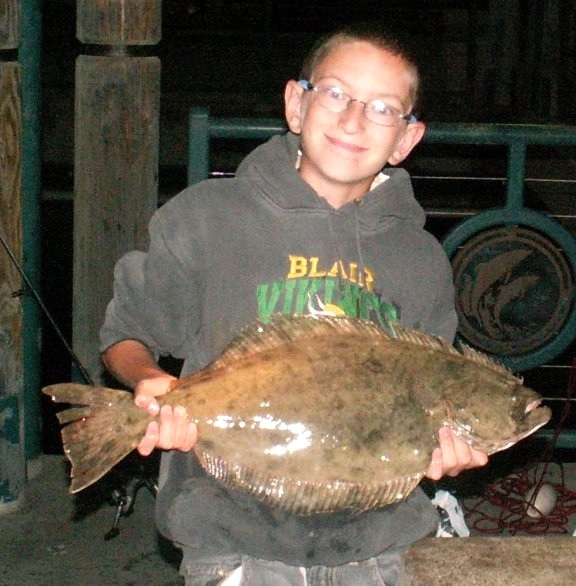
Daniel’s first keeper halibut
Fishin’ is easy but catchin’ is sometimes a little more difficult. Most of the regulars, and they are the ones who typically know what they are doing, use live bait for halibut. At Redondo that usually means small smelt, shinerperch, sardines or baby macs that you’ve caught yourself. A small-hook bait rig, i.e., Sabiki rig, will catch all of these. A drop net is better since it will not harm the “live bait” but it will primarily only yield smelt or perhaps a small perch.
Once you have some live bait use a Carolina-rigged leader with the live bait for the halibut, a slider rigging, or a two foot or so long leader tied up above the sinker (see the book Pier Fishing in California, The Basics). Traditionally the seats along the Monstad portion of the pier have been considered the prime halibut area, especially the inner portion of those seats.
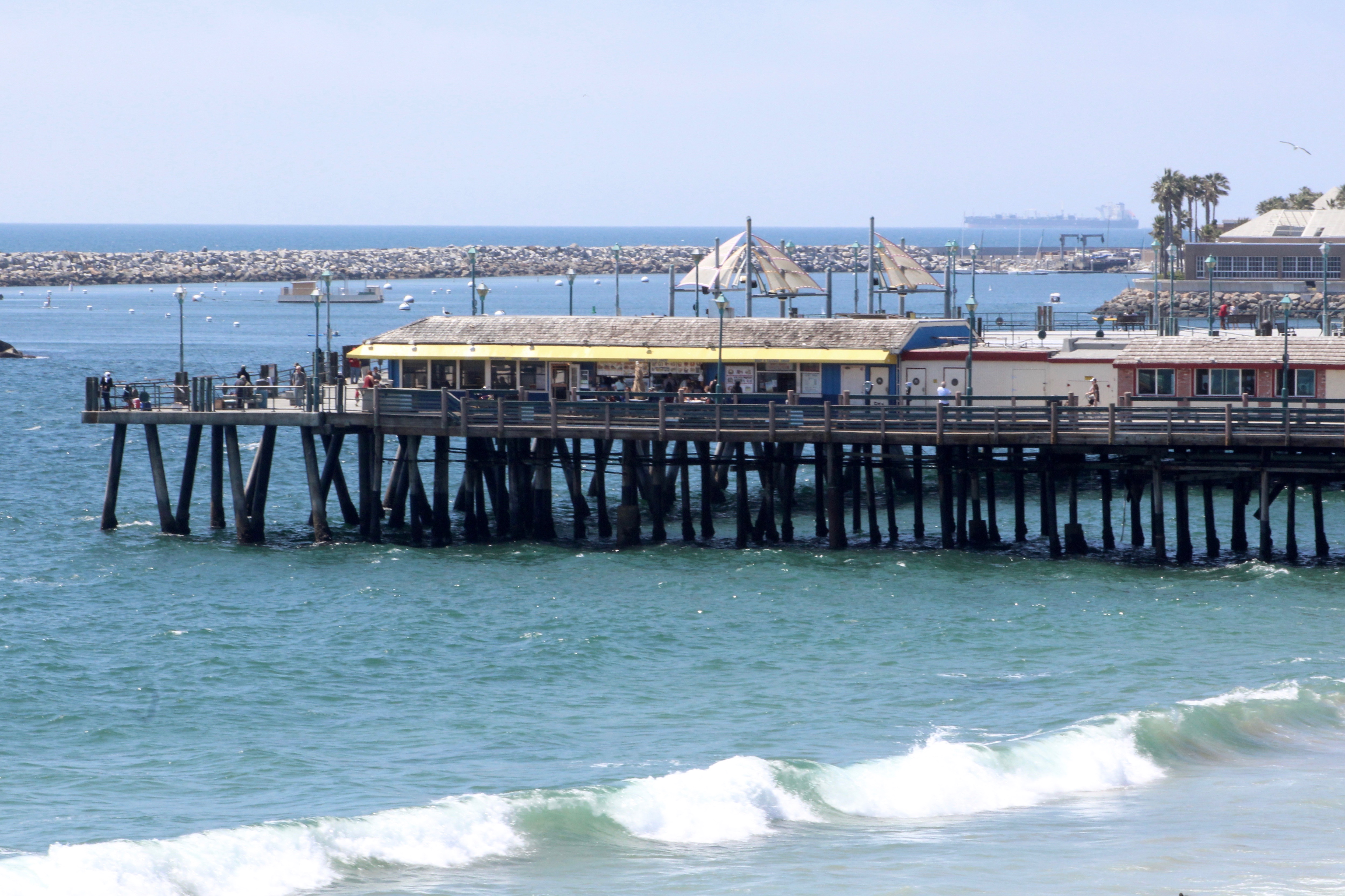
The Monstad section of the pier
Recently I ran across an article that discussed the Monstad section of the pier that pretty much confirmed what I already felt about the best area to fish on the pier. The nearly 40-year-old article also mentions the dilemma that still confronts “pier rats” and the cities that maintain the piers: the cost of the upkeep of the piers. How to balance the space needed by the fishermen versus providing space to businesses that can produce revenue for the upkeep of the pier. Without the money to maintain the pier there would be no pier and no one would be happy.
Restaurant Proposal Angers Fishermen
The Monstad and Municipal pier at Redondo Beach is the most visited coastal pier complex in California, according to Richard W. Parsons, harbor director.
For years, local fishermen have peacefully coexisted with commercial developers on the pier but a recent city revenue-producing proposal to build a restaurant on the south side of the Monstad pier has infuriated the rod-and-reelers.
“This is the best halibut fishing pier in the state,” contends Ray Amys, leader of a drive to stop approval of the restaurant in the Coastal Commission hearing.
The city proposes to relocate the fishermen to a 212-foot promenade joining the Monstad and Municipal (horseshoe) piers but fishermen scoff at the idea, saying that they won’t catch any halibut there, only much less desirable fish like perch, mackerel and bonito.
“People come from Long Beach, San Diego and all over the state,” Amys says. “On the Long Beach pier, it’s a big thing to catch a 14-pound halibut but here it’s an everyday occurrence,” George Whalen, fisherman from Long Beach, said offhandedly.
Fishermen who have been fishing the piers for decades say they have learned that one section on the south side of the Monstad pier is where the good fishing is. They’ve seen excursion boats go out near the pier and have seen they don’t catch fish.
There is scientific reason for it, according to Rimmon C. Fay, a controversial member of the Coastal Commission. “I know from firsthand experience diving down there that the Redondo submarine canyon comes into shore right along the south side of Monstad pier,” Fay explained.
People fishing on the end of the Monstad pier don’t catch fish like those on the south side, Fay said.
The canyon attracts the fish from off the coast from its 600-700 foot depth offshore (compared to the surrounding 80- to 90-foot depth). Beside the pier the water is 50 to 60 feet deep, compared to the surrounding 20- t0 30-foot depth, Fay added.
Wishing to maximize the city’s revenues, harbor director Parsons approached the State of California Wildlife Conservation Board about funds for construction of additions to the existing Redondo piers.
There is no environmental issue here, according to local fishermen. It is rather a classic confrontation over the access of low- and moderate-income people to coastal areas.
The pier is used by fishermen who don’t have money to go out on boats and fishermen do not generate revenues for the city while the developers do produce revenue, Fay explained.
Estimated to cost $300,000, the proposed fishing promenade would join the Monstad and horseshoe piers, giving an additional 400 feet of fishing rail space…
It is common knowledge among fishermen that live bait, specifically anchovies, are needed to catch halibut. The developers and the city say that a 30-foot open platform will be provided for the bait boat to land but bait boat operator says “no way.”
“The plans call for me landing 100 feet behind where I do now—the water is too shallow—I would run aground. I’m not going to risk a $200,000 boat going in there,” Myers said flatly. Myers said the developers don‘t realize how much water bait boast draw when they’re full.
Compounding the problem, the boat would have to land in ocean swells between the two buildings, Myers added, “Without live bait, the pier would be dead, “Myers affirms…
The fishermen argue that the retail complex will destroy the view to seaward, while the city and developers say that will be more than offset by the new vistas created by the proposed promenade.
The fishermen have rallied around a statement by former Coastal Commission member Fay, who said “you can put a restaurant any place but you can only catch fish in the ocean.
Responding to the pressure, the city presently has a consulting engineer studying the feasibility of constructing a low-level fishing rail below the proposed restaurant on the south side of the Monstad pier.
Harbor director Parsons feels that the whole controversy is ironic because progress is part of the reason a lot of fish are attracted to King Harbor. Through offshore conduits, Southern California Edison absorbs water, filters it before using it and discharges it back into the ocean cleaner than it was before, Parsons explains.
Parsons said that pier structures are expensive to maintain. In an average year, it costs about $150,000 to maintain the two Redondo Beach piers, not counting extra expenses like the $300,000 the city spent for a 10-inch fire main.
Because the water in the harbor has gotten cleaner, a termite, which cannot survive in dirty water is thriving, attacking pilings, each of which costs $5,000 to replace. “The fishermen want us to leave the pier alone but if we do, it will be condemned,” Parsons said. The nearby Bounty restaurant structure has already been condemned.
Amys expects to have 5,000 signatures by the time the Coastal Commission hearing takes place. Pollack explains that the master lease agreements include provisions that 50% of the retail space remain open for fishing.
Mel Carpenter, executive director for the South Coast California Coastal Commission, indicates that the Coastal Commission staff is willing to recommend a modified version of the proposed plans but points out that doesn’t mean that any members of the Coastal Commission will approve it or deny it.
—Diana Sherman, Los Angeles Times, May 20, 1979
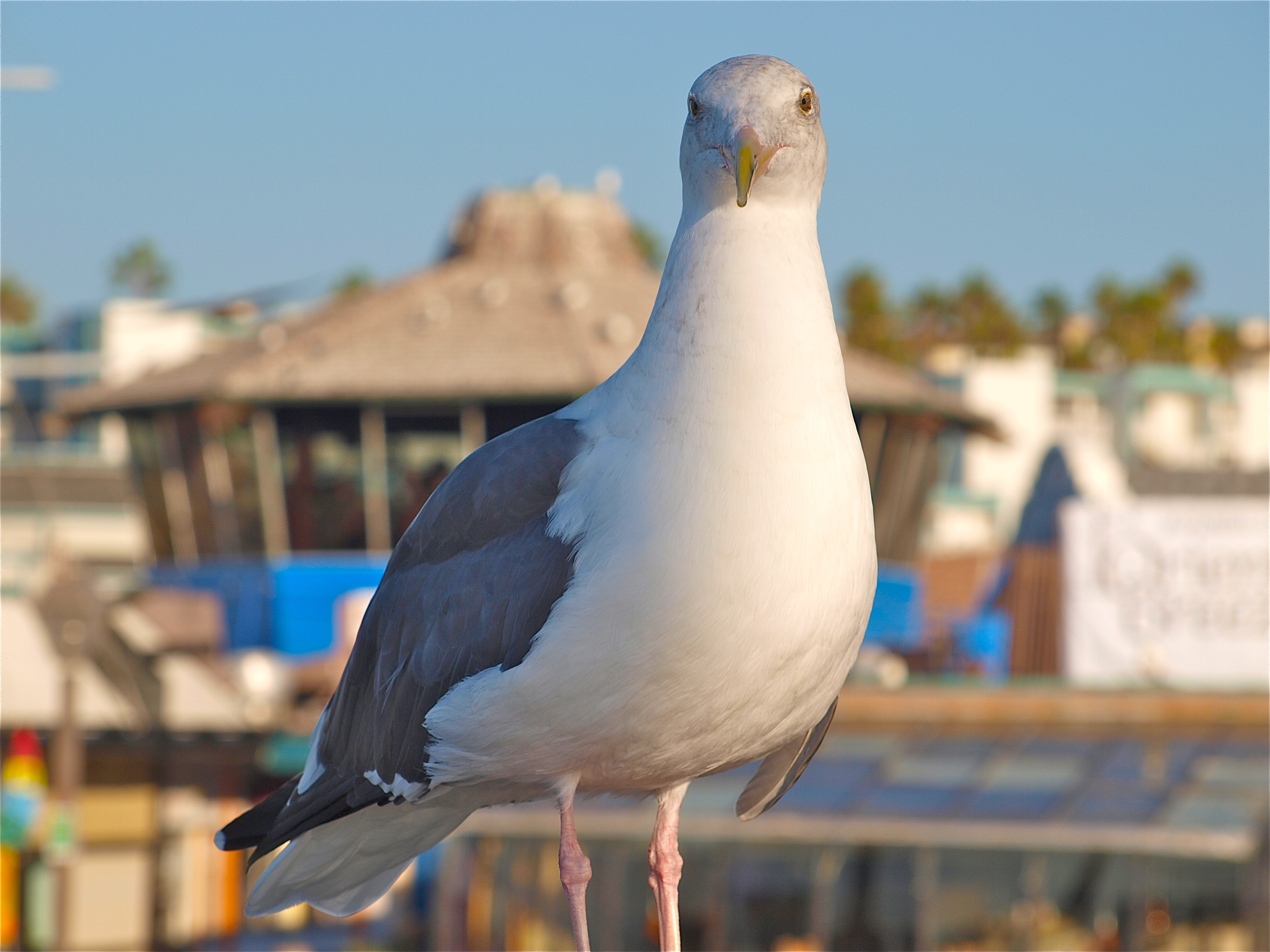
I assume the anglers won that round since Tony’s Restaurant still sits on a wing of the horseshoe pier. But their victory would be short lived. Winter storms in 1983 destroyed much of the end of the pier (less than four years after the fight and article). Five years later, in 1988, winter storms in January and February combined with a disastrous fire in May, devastated the entire pier. A new pier would rise like a Phoenix from the ashes but it would not open until 1995, seven years later. And today, even though the Monstad section is still available, live bait isn’t — and the number of halibut are far down.
Nevertheless, the following articles give further evidence that halibut have long been the prize fish at the pier. However, the first article, from 1975, is not accurate as far as the fish being a record (at that time). A 62 ¼ lb. halibut was caught at the Los Angeles Long Wharf in August 1917, a 54-pound fish at the Huntington Beach Pier in 1939, and a 45 ¾ lb. halibut was caught from the Balboa Pier in May of 1927. It does show though that some big “barndoor” halibut were found at Redondo. The next two articles show that halibut were often the derby winners (although sharks and rays were generally excluded from the derbies).
Woman Catches 45 ½ L.B. Halibut
A Los Angeles County woman landed a 45 ½-pound California halibut at Redondo Beach pier June 24, to narrowly miss the state hook and line record by a little more than a pound.
Nevertheless, it was the largest halibut ever taken from a pier, and Virginia Lively of Carson has entered her “barn door” in the Fish and Game Commission’s annual trophy awards program.
The state record is a 46-pound 8-ounce halibut taken off Santa Cruz Island on March 31, 1974 by Ron Buhr of Santa Ana.
Mrs. Lively, a veteran angler, used a No. 1 hook on a 10 pound test line to land her catch at about 9:45 a.m. It took her about 10 minutes to get the fish up on the pier. She used a live anchovy. The halibut measured 45 ½ inches in length, and marine biologists estimated its age at between 13 and 17 years old. The largest California halibut ever verified by the DFG was a 51.375 pounder taken by a South Gate spear-fisherman in the late 1950s.
—Joe Mears, Great Outdoors, Long Beach Independent, July 2, 1975
Redondo Angler Wins
Redondo Beach resident Robert McLaughlin won the first Redondo Beach Pier Fishing Championship, landing a 17-pound halibut to top 74 entries. The contest began June 1. The top 10 finishers will receive prizes in a ceremony at 6 p.m. today on the pier.
—Los Angeles Times, September 11, 1986
Halibut Take the Hook in Randy Martin Awards Tourney
The Sgt. Randy Martin Awards ceremony was held Thursday on the Redondo Monstead pier and, with the end of the tournament, halibut in particular may have felt that the 126 entrants in the third annual event had declared a cease-fire.
First place went to Hasid Homas of Redondo Beach for his 16-pound, 6-ounce halibut caught on the first day, which rewarded him with a trophy, a complete fishing outfit and a jacket.
Second-place winner was Jerry Dunamac of Wilmington for his 16-pound, 3-ounce halibut. Dunamac received a trophy and tackle.
Third-place finisher Leroy Nelson of West Los Angeles caught a 16-pound, 3-ounce halibut. He received a trophy and fishing gear.
Charlie Middleton, 91, of Redondo Beach was the oldest fisherman and received a rod and reel. Middleton said he fishes 300 days a year and he is concerned about the crowded condition on the pier since the front section that was destroyed by fire has not been replaced.
The youngest participant was 6-year-old Redondo pier angler Chancie Rabotsan, who received a junior award.
—Dan Stanton, Los Angeles Times, September 15, 1988
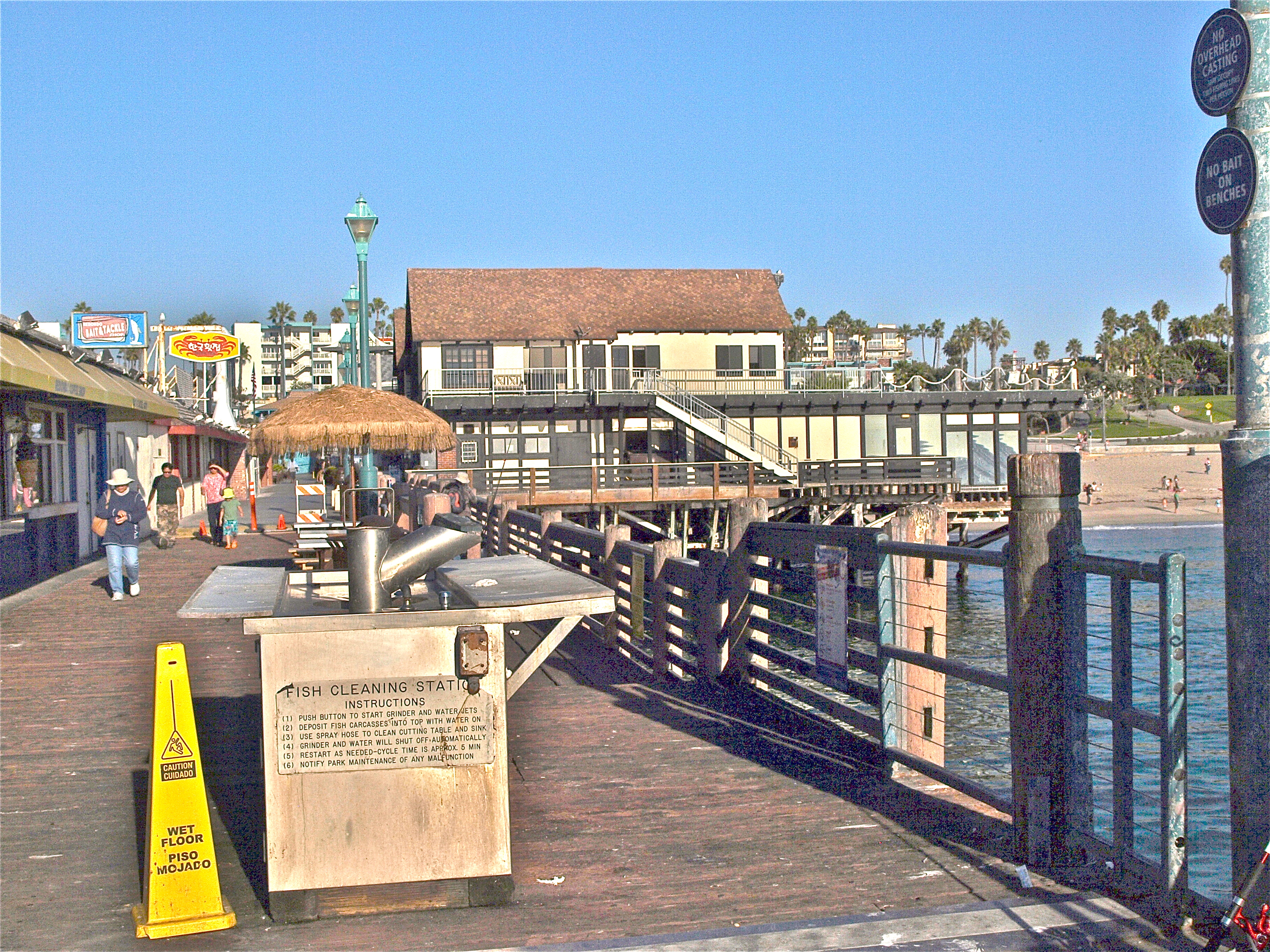
A large fish cleaning sink sits in the Monstad section of the pier
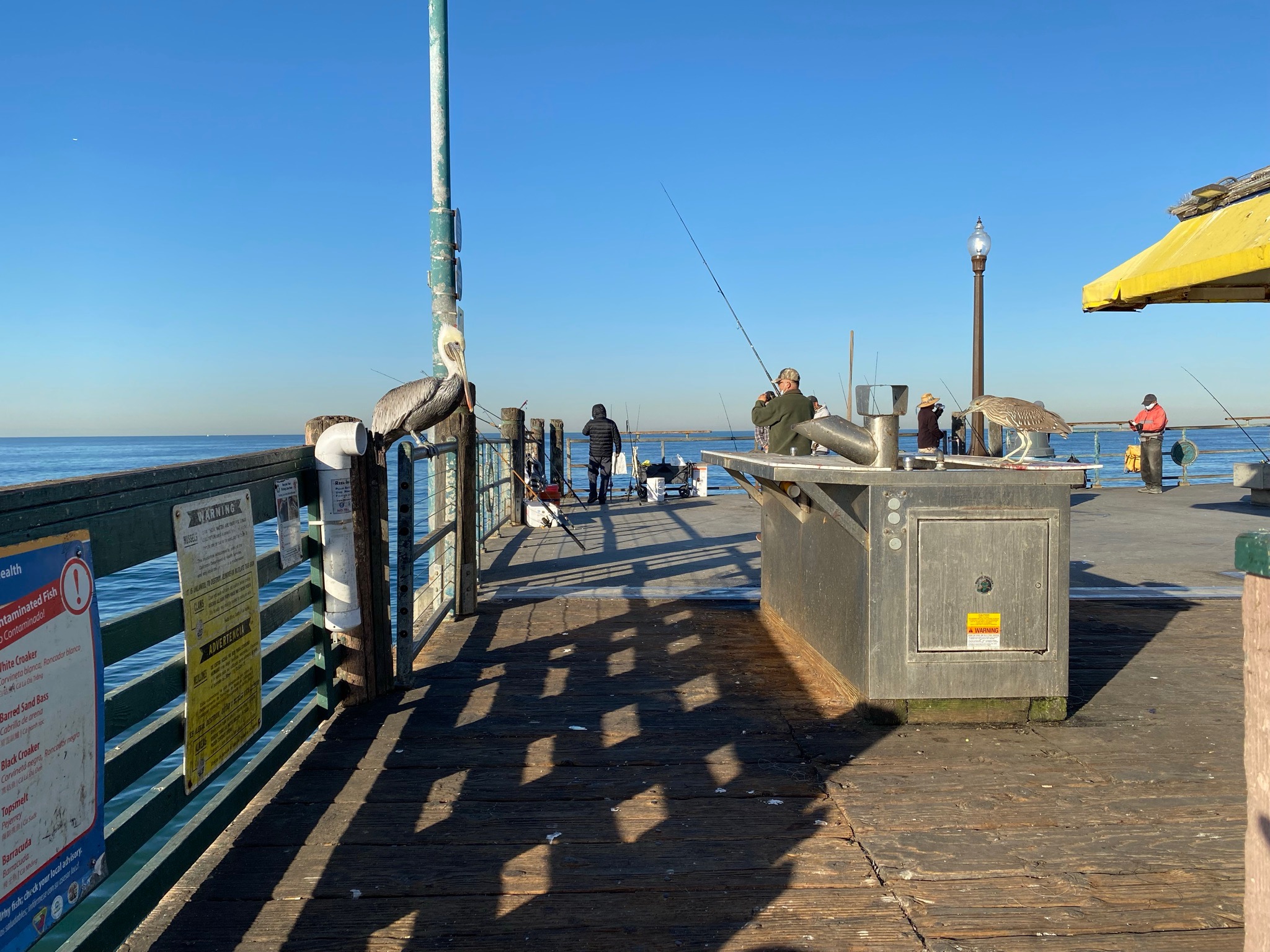
Inshore fish. Of course there are other fish than mackerel and halibut at the pier. Anglers casting back toward the shoreline from the end section, or better yet, fishing on the diagonal legs of the municipal pier, can fish the shallower, inshore water. Yellowfin croaker are often available and a few spotfin croaker and corbina might show up. If fishing at night, you might see an occasional black (China) croaker. Young white seabass (sea trout) may show up in the spring but their numbers are rarely high.
All of the croaker will hit on high/low riggings baited with seaworms (bloodworms or lugworms), fresh mussels, ghost shrimp (if you can find them), or small pieces of market shrimp.
The large schools of the smaller croakers—queenfish (herring) and white croaker (tomcod) do not seem to be present here as at the more surf-oriented piers. Nevertheless some may be taken.
The white croaker will hit a piece of bloodworm or lugworm fished on the bottom on a high/low rigging with size 6-4 hooks. The queenfish can hit on the same rigging but are more commonly taken on small-hook bait rigs jigged mid-depth in a simple up and down motion. For the queenfish, drop to the bottom and if no bites are happening bring it up a foot. Repeat until you find the schools (and usually they are halfway to the bottom).
You may also see schools of salema which prefer the same water depth as the queenfish, like the same baits and, like queenfish, are often far more ready to hit at night than during the day.
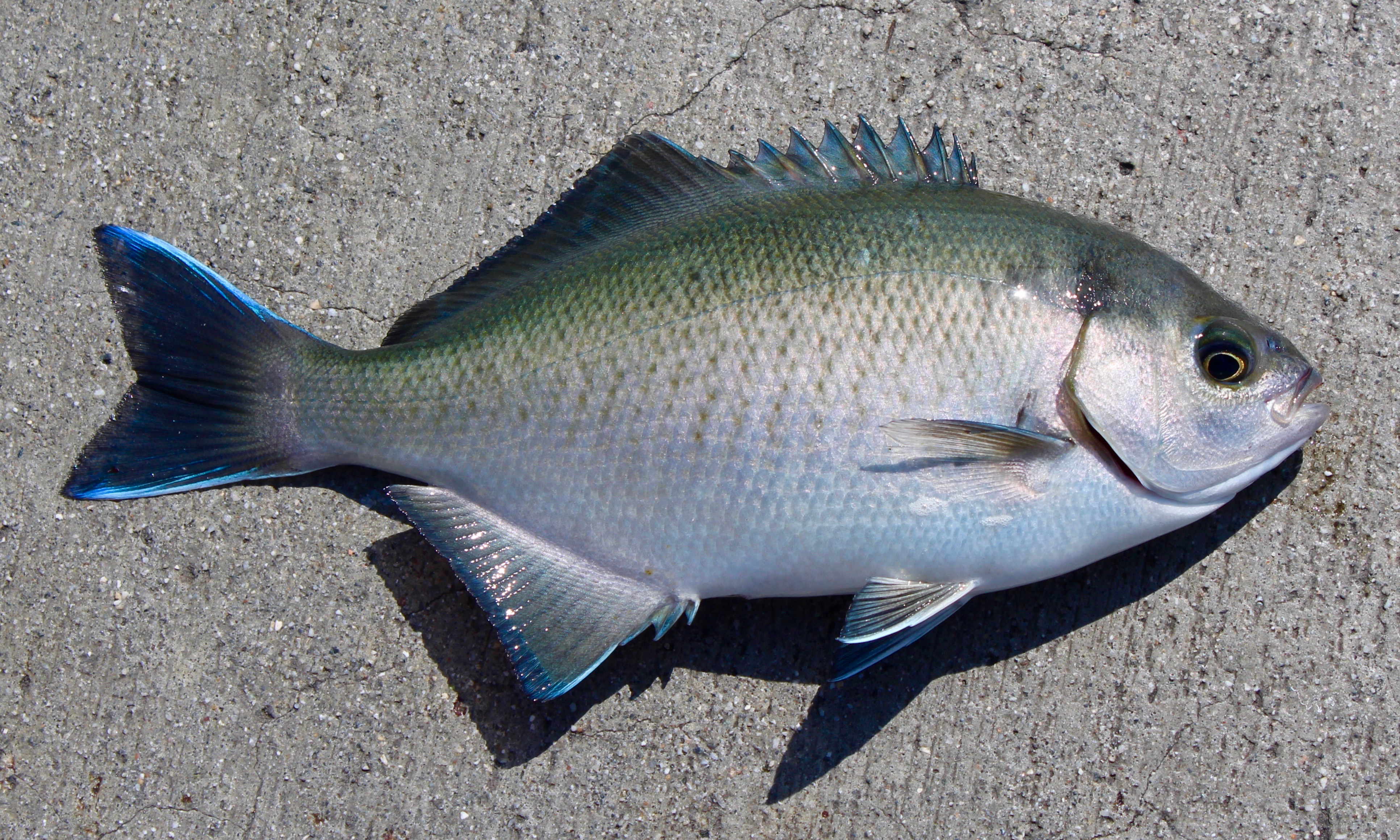
A halfmoon I caught one day casting “under” the Monstad section
Perch, flatfish and miscellaneous species. Although perch are a major component in the catch at most SoCal piers, they represent a fairly small number at Redondo. The exception is small shinerperch, which can seem to saturate the waters at times. Few barred surfperch seem to be caught inshore and the larger perch that like to hang around pilings—blackperch (buttermouth perch), rubberlip perch, and pileperch, are rarely seen. White seaperch are sometimes caught on the bottom, and walleye surfperch mid-depth, but both are rarely taken in the numbers seen at some piers. Worms, fresh mussels and small pieces of shrimp work best for most of the perch while a Sabiki can be all that is needed for the walleyes.
Perch-like sargo are a possibility and there are a few opaleye and halfmoon down by the pilings but few people seem to target them. If interested use a high/low rigging with size 6 hooks and baits like worms, fresh mussel, pieces of market shrimp or ghost shrimp; fish a foot or so off the bottom.
An interesting and good eating fish found on the bottom, one especially common at night and during the winter months, is the misnamed sculpin (California scorpionfish and actually a rockfish, not a member of the sculpin family). Most are taken using a high/low rigging with a piece of shrimp or strip of squid for bait.
I’ve seen relatively few kelp and sand bass taken at the pier. However, kelp bass in particular are present and their numbers may be rising. They will take almost any bait and a high/low fished on the bottom under the pier by the pilings is often most productive.
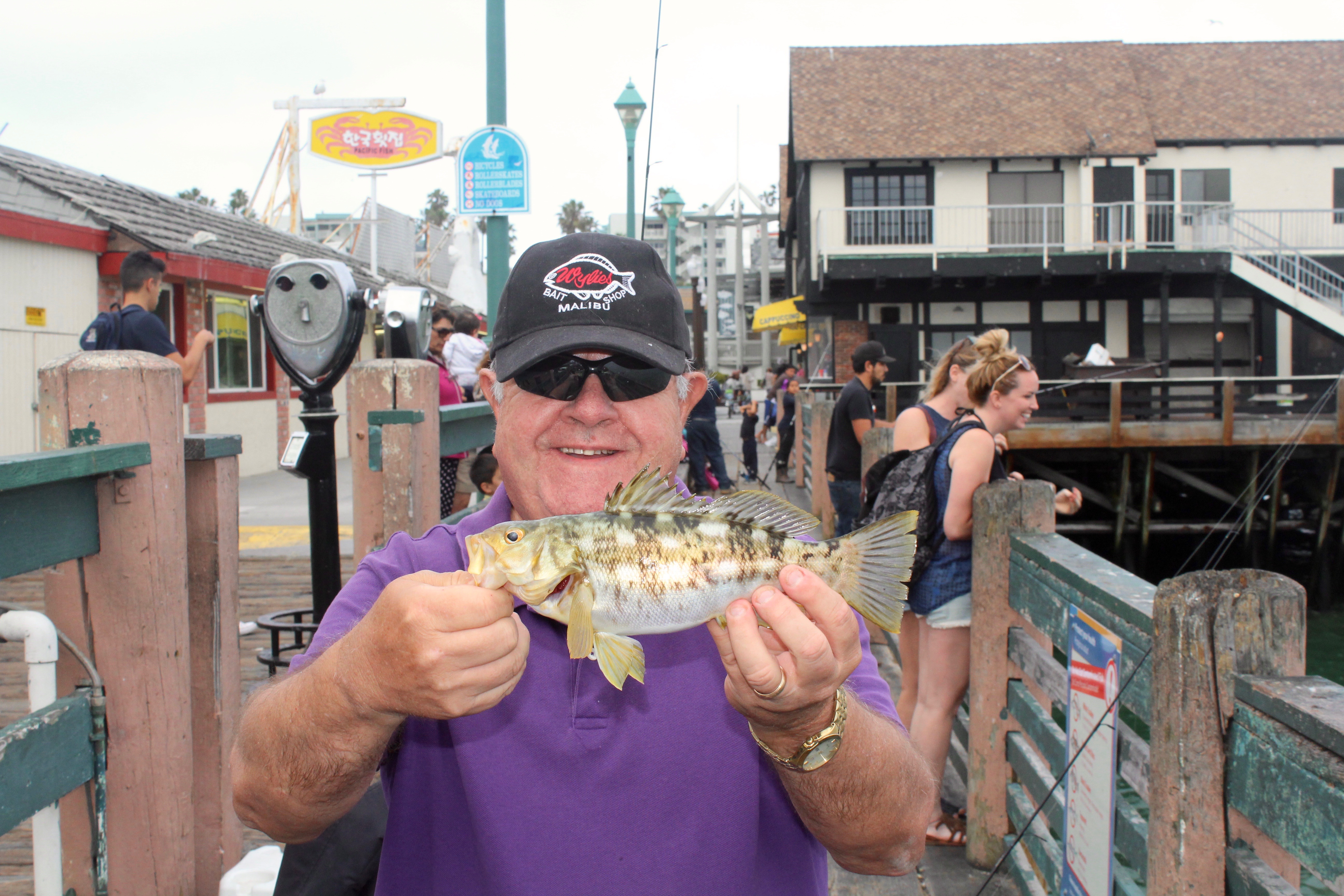
A kelp bass I took one day while fishing in the Monstad section
I’ve been told that an occasional ocean whitefish can be caught from the deep-water corner of the Monstad section. A long cast using a long rod and heavy sinker can reach a pretty good depth of water and apparently that’s where the whitefish show up when they are around. Although occasionally plentiful on the Catalina piers, they are uncommon at mainland piers.
As for smaller flatfish, sanddab, sole and turbot may show up. I’ve seen Pacific and longfin sanddab taken from the pier as well as many speckled sanddab; C-O sole, and Diamond turbot are flatfish infrequently taken. The best rigging for all is a high/low rigging with size 6 hooks and a piece of saltwater worm covering the hook. They all have fairly small mouths and the bait needs to be fairly small. Cut anchovies or mackerel, pieces of shrimp, and small strips of squid may take a few flatfish but keep the bait small.
One fish that is somewhat detested is lizardfish but the number of lizardfish has shown an amazing increase along the coast and it’s the same here. Sometimes they will seem to cover the bottom and may show up on every hook of a Sabiki sent out in search of mackerel—if the angler is careless and lets the Sabiki sit on the bottom. Some people like to eat them—some don’t. They are considered good live bait for halibut.
Big ‘uns. One question that occasionally is asked is if there are still big fish at the pier. The answer of course is yes, especially during the warm water years when yellowtail visit the pier. A post on the BloodyDecks website in 2009 gave evidence:
Posted by joser85, Date: October 8, 2009
“Last week Thursday me and some buddies were fishing off the Redondo Beach pier. The bonito has been coming in so perfect time to have some fun with light tackle. Any ways, this guy next to us [was] catching mackerel like crazy when out of nowhere his rod just gets bent HARD. Since he was fishing for mackerel with Sabiki hooks we think SEAL. So, we pay no attention to him. After a few minutes of him fighting what we thought was the seal we start to double think of what can be at the end of the line????? Maybe black sea bass? Finally after about 20 min we see color. NO…way, it’s what I think is a YELLOWTAIL. And not just any yellowtail. A BIG… yellowtail. This guy had like 20-lb test, but what made him actually land the fish was that the Sabiki got wrapped around the fish causing the yellow to hardly put up a fight. One of my buddies runs over and grabs his pier gaff. Right when he drops it guess who shows up!!!!!!!!!!!!!!!! A fishermen’s worst enemy, MR SEAL & not just a regular seal this boy had to be about 1000-lbs. He took 3 bites at the fish and on the last one he popped the line. After a few seconds we see the seal come back up and leave. Automatically we think he ate the whole… fish. But for some reason this guy starts dragging the bottom with a treble hook and after about an hour or so we see he’s snagged on the bottom. He starts to reel in slowly and what comes up… the yellowtail. We help him get it on the pier and holly…. it‘s even bigger that what it looked like. The fish measured 54” long and estimated at 40lbs. What a…day.” [Edited]

Picture of the yellowtail (courtesy of Bloody Decks)
The other big ‘uns are undoubtedly the large sharks and rays, especially big bat rays that are sometimes taken but usually at night when fewer people are around to “ooh and aah” at them.
Crustaceans — Lobsters and Crabs.Spiny lobsters are found at the pier but unfortunately the constant poaching over the years has made it difficult to catch a legal-size “bug” during the lobster season. People catch and keep them on their fishing lines (illegal). People catch shorts and do not return them to the water (illegal). People catch them out of season and keep them (illegal). I have friends who were once regulars at the pier at night using hoop nets for lobsters. Most have now given up on the pier due to frustration: the dual frustration of watching people break the rules and nothing being done about it, and the frustration caused by those actions—a lack of lobsters. If you do want to try for the bugs use a hoop net follow the rules!
A couple of newspaper stories from nearly a hundred years ago gives evidence that the problem isn’t new but at least in one case the angler tried to do the right thing.
Curious Lobster Causes Trouble — Fisherman Explains To His Honor How Catch Occurred
Redondo Beach, Sept. 29.—The curiosity f a lobster which led it to sample bait intended for a halibut landed the lobster, the angler, and a number of interested spectators, in Judge W. M. Browning’s court here, this morning.
From the evidence it appeared that J. Hanson was peacefully fishing from pier No. 3 yesterday afternoon when he pulled in a clawed creature of monstrous size. Leaving his prize on the wharf the man, it was stated, went to find out about the game laws and see if he could enjoy a lobster salad, hand picked.
But in the meantime Game Warden C. F. Maddex of Los Angeles had been notified that lobsters were being captured at Redondo Beach. The season does not open for some fifteen days yet so the official came down to investigate. The first thing he found was the biggest lobster he had ever seen, which, when weighed, balanced at twelve and a half pounds.
The lobster was attached and the luckless fisherman cited to appear to answer the charge of violating the game laws. As it was not proven that the lobster was caught intentionally, nor that the man intended to keep it, the case was dismissed. Constable J.V. Henry carefully deposited the lobster back in the ocean after it was introduced as evidence in court. It was rare the worse, apparently, for its night out.
—Los Angeles Times, September 30, 1919
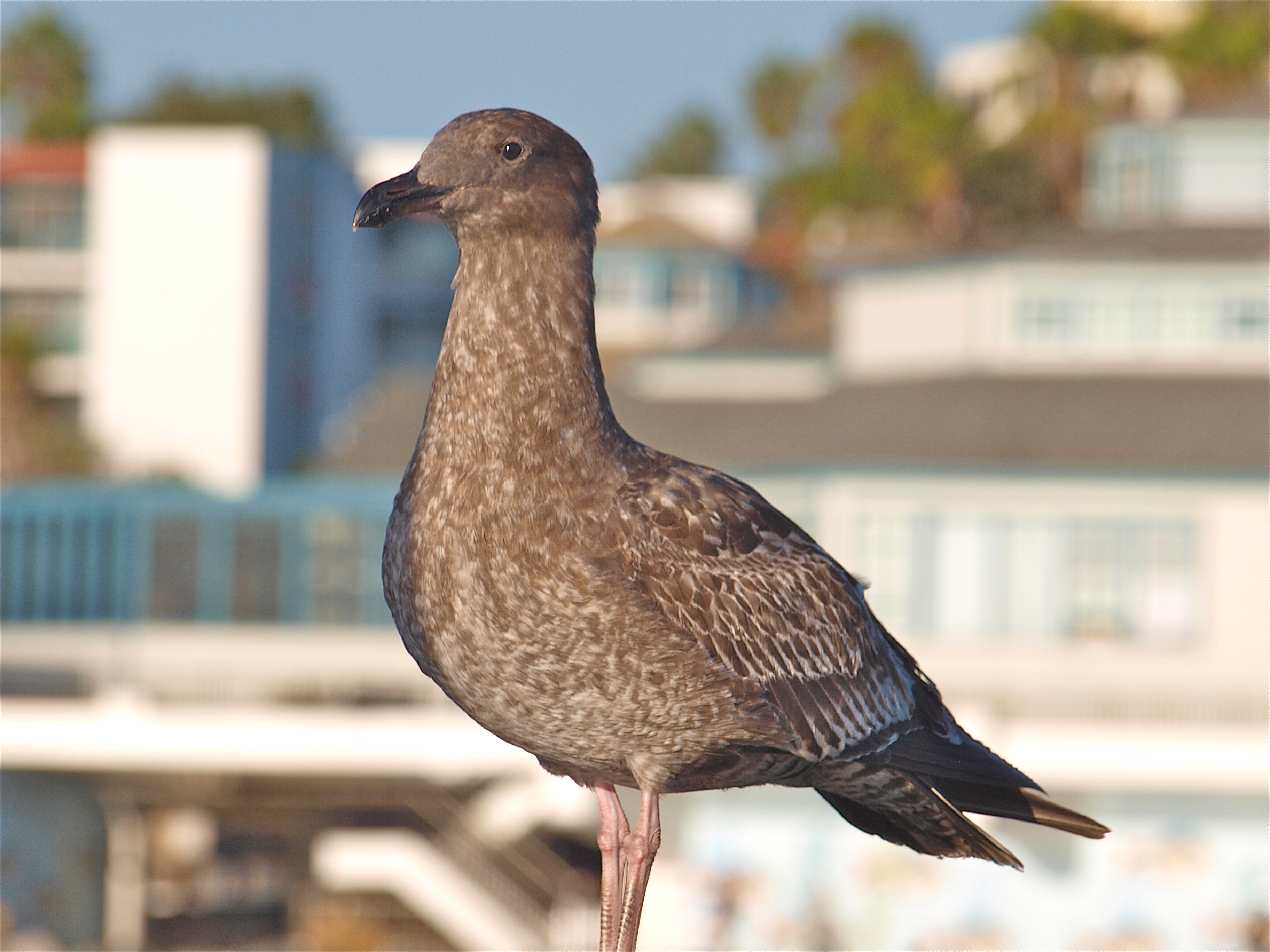
Conduct Drive Against Anglers As Deep Sea Limit Is Exceeded
Los Angeles, Sept. 13.—Payment of a fine of $100 by M. A. Peterson, and nominal assessments in four other cases resulted from a drive made recently on the fishermen and fish markets at Redondo Beach by deputies of the commercial fisheries bureau of the division of fish and game, who have been putting in many an hour both day and night in an attempt to clean up violations of the laws in that district.
Peterson and four other fishermen were apprehended by Deputies Ross Markley and Tats Miller as they drove off the pier at Redondo. Peterson had 69 lobsters which it is illegal to take at this season of the year, and an examination of the lobsters disclosed the fact that most of them were also undersized.
—San Bernardino County Sun, September 14, 1929
The pier can also be a pretty good one for crabs although most of the crabs are the gnarly old spider (sheep) crabs). They reach a good size and can be pretty good to eat although cleaning them can be a fairly big chore. A few yellow crabs are also taken but here they seem secondary in nature to the spider crabs.
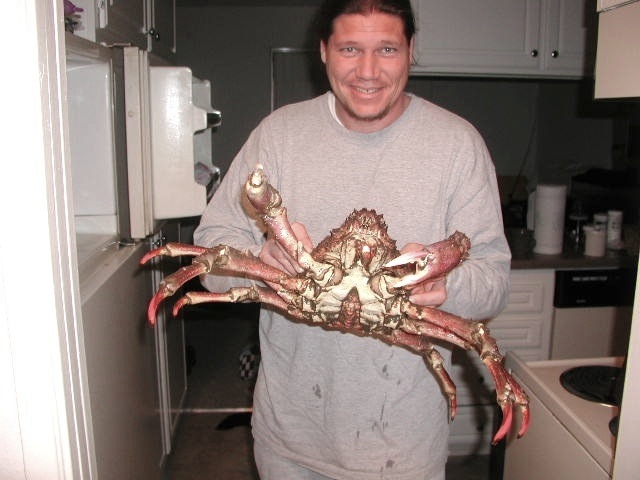
A large spider (sheep) crab caught by SanClementeEric
Cephalopods. Given the nature of the nearby deep-water canyon (where squid spawn) and the attention it receives from the “squid” boats, one might think Redondo would be a good pier for market squid and the larger Humboldt squid (when they show up). Alas, that doesn’t seem to be the case although it’s true there are nights when the smaller squid do show up. It’s not a reliable fishery and has not, to my knowledge, ever been a major player in the story of the pier.
While runs of giant Humboldt squid have made the news concerning several piers (especially Newport and Balboa) it hasn’t seemed to happen here—and I do not know why.
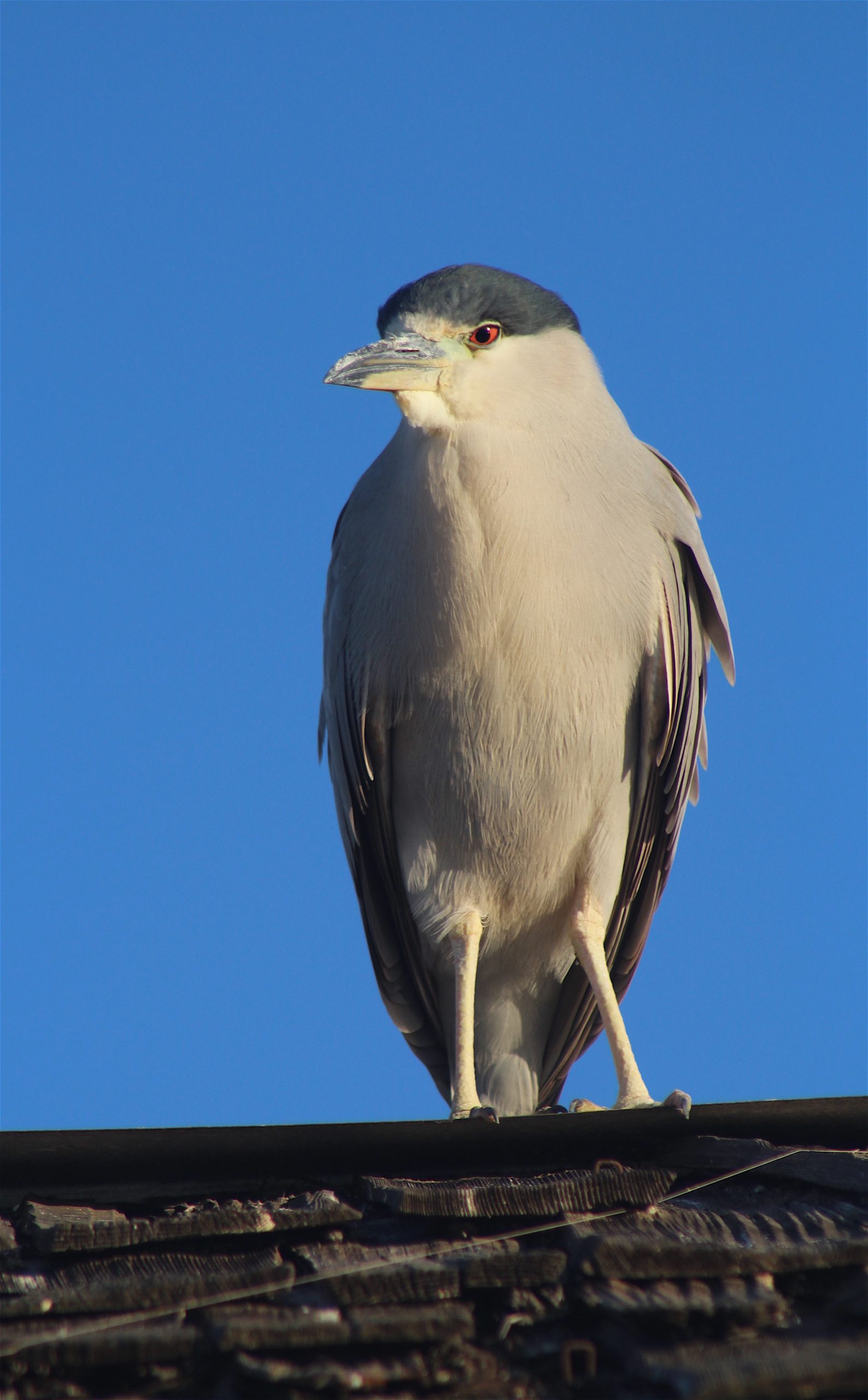
Do Not Eat Contaminated Fish!
A final note concerns eating fish in the area. Large signs on the pier proclaim—“Protect your health—Do Not Eat Contaminated Fish!” Although different species have been included in such signs over the years, the current signs say to not eat white croaker, barred sand bass, black croaker, topsmelt, or barracuda.
The cause of the warnings is a variety of toxins found primarily in the local mud and sand on the bottom that contains DDT and PCB. The toxins are absorbed by the worms and other creatures living in the mud and those smaller creatures are eaten by the larger species including fish. The inclusion of barracuda is a little surprising although the fact that young barracuda spend much of their lives in bays, and bays are often the most polluted areas for various toxins, may explain why they are included.
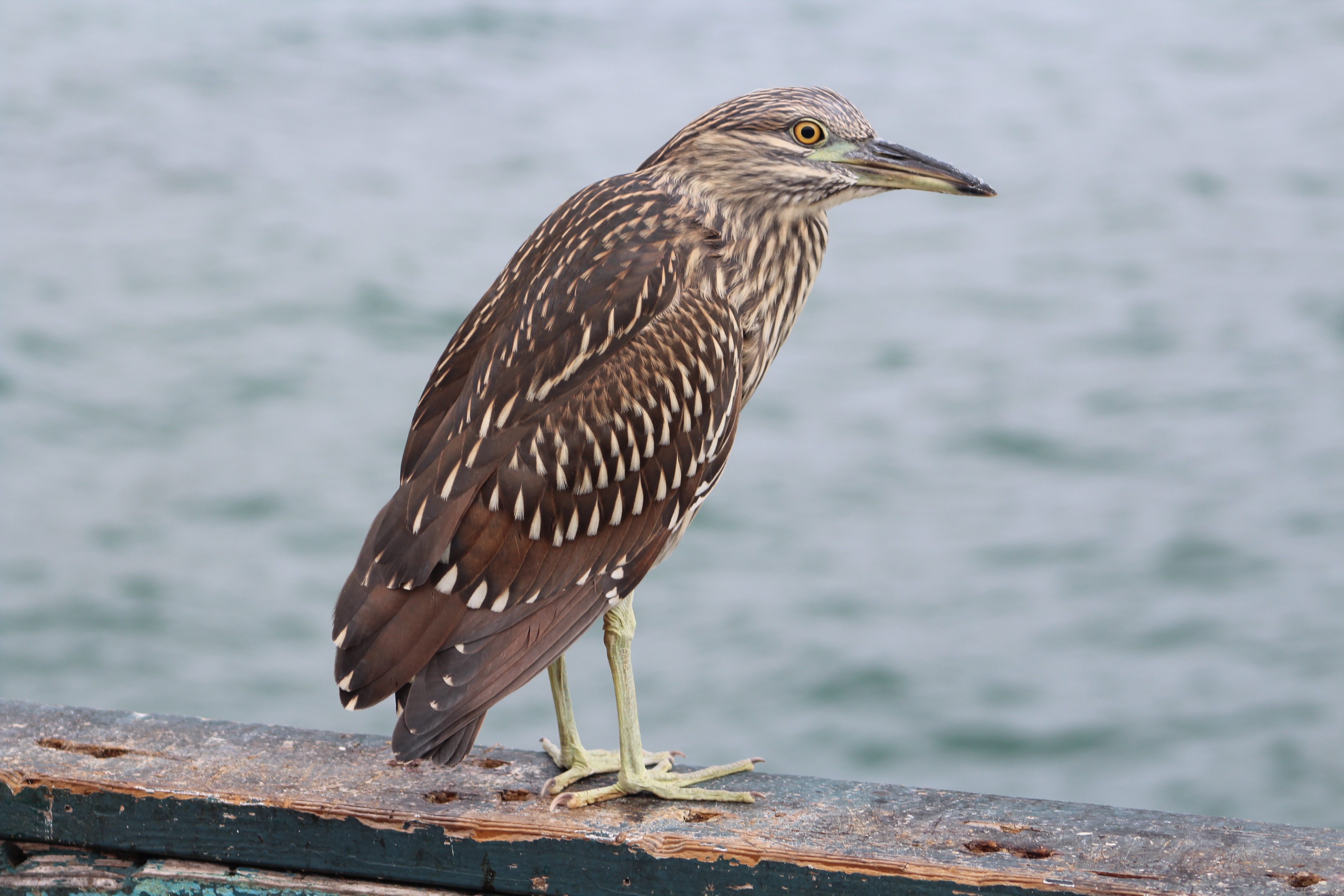
Potpourri —More than you may want to know about the Redondo Pier
<*}}}}}}}}}>< — By the 1920’s, Sportfishing boats had begun to operate from the pier, both live bait boats and barges. The barges would perhaps gain the most fame since the number at Redondo were the greatest of any port and they would operate the longest—from 1922 to 1998.
The first was the Margaret (1922-23), perhaps California’s first fishing barge. It began operation in 1922 and was followed chronologically by Bill’s Barge (1920s), Challenger (1923), Challenger II (1923), William Bowden (1925-26), Lahaina (1925-33), Fullerton (1925-27), Jane L. Stanford (1926), Georgina (1927-35), Thomas P. Emigh (1927-31), Point Loma (1927-30), Bonnie K. (?), Kohala (1928), Aileen (1930s), Melrose (1932), Emperor (1938), Oceania Vance (1935-36), Irene (1936-37) and Sea Witch (1939). All of these ceased operation during World War II. Following the war a new number of new barges emerged—the Manana (1940s), Buccaneer (1950s), Retriever (1950s), Sacramento (1950s), California (1957-1981), and the last barge, the Isle of Redondo (1981-1998). In addition, the Aurora may have been at Redondo a short time in the mid-‘30s.
During the 1920s and ‘30s the barges were filled with anglers. At a cost of $1, cut to .50 during a price war, anglers could catch a taxi to the barge and fish all day—or night (in some cases). Mackerel were usually the main fish caught although big numbers of barracuda and halibut were frequently seen (and some of the halibut exceeded 50 pounds in weight). Yellowtail were seasonally common as well as white sea bass. Giant sea bass, originally called Jewfish or black sea bass, were common fish on the barges and fish up to and exceeding 400 pounds were caught. Some anglers specifically fished for the giant bass. Kelp bass, sand bass, rockfish, croaker and other miscellaneous bottom fish made up the remainder of the catch.
Redondo’s most famous fish may have been a 532-pound black sea bass caught on Bill’s Barge (Bill Hall’s barge off the pier in 1925). Eli Dessery, the business license administrator for Redondo Beach, caught the fish. He hooked the fish using an one-pound mackerel bait, fought it for 85 minutes, and donated it to the local Salvation Army when he got back to shore. Two of the “Sally” workers, Captain Margaret Rice Cole and Lieutenant Lila Ward, then borrowed a flatbed truck, put on their aprons, and headed out with sharpened cleavers to distribute the fresh food to the needy.
28 Jewfish Caught at Redondo Beach
The total number of jewfish caught at Redondo since the first of May was brought up to 28 yesterday, following the catch made by William Smalley of a jewfish weighing 368 pounds. The largest fish caught since May 1 weighed 489 pounds, while the smallest was a 232-pounder. All other fish have been biting fairly well.
—Redondo.bargee
Many anglers, including myself, lament the loss of barge fishing and unfortunately my experience on the Redondo barges was limited to two trips. The first, in July of 1978, was on the barge California, and it was an all-night trip. The barge had hourly “taxi” runs to the barge that started at 7 a.m. in the morning and ended at midnight. If you chose to stay past midnight you could fish all night. There was a full galley and places to curl up if you got sleepy. I was on a fishing trip and returning north. I figured why not combine some fishing with a place to stay for the night; why pay for a motel? I headed out to the barge at 7 p.m., fished most of the night, and returned (somewhat sleepily) at 7:30 a.m. in the morning. Luckily, the boat was anchored near the deep-water Redondo Canyon and as a result I saw a nice mix of the deeper water rockfish along with some sablefish, another deep-water fish and one of my favorite eating fish. The seas was calm, the night was beautiful, and I managed quite a few fish—54 bocaccio (rockfish), 14 Pacific mackerel, 5 sablefish, 1 rosethorn rockfish, one blue rockfish and one white croaker. As to the number of fish, naturally I only kept my limit.
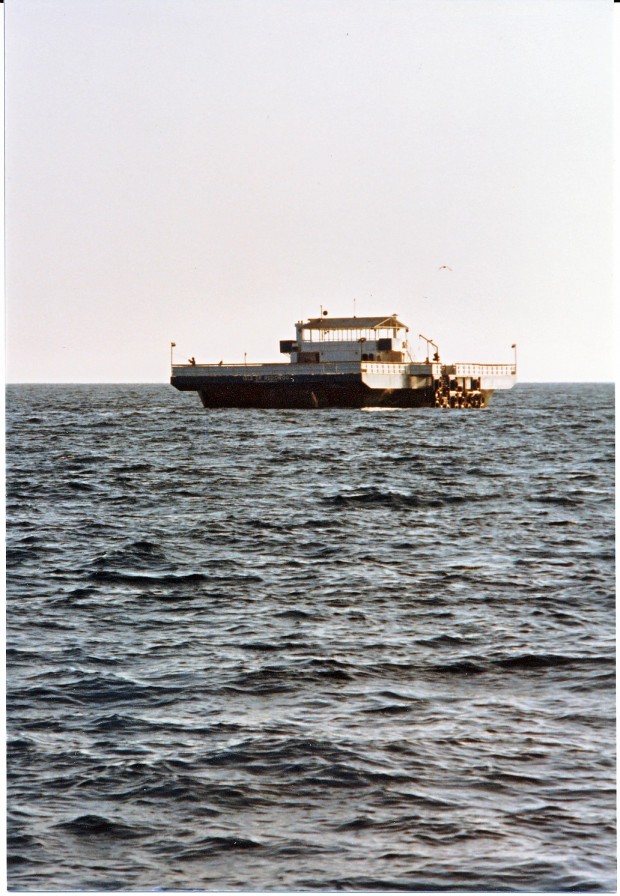
A few years later, in August of 1982, I returned for a somewhat shorter trip but one that also took place in the evening. The barge was now the Isle of Redondo. I taxied out at 6 p.m., fished 6:30 to 11 p.m., and arrived back at 11:30 p.m. The fishing was not as good although I did manage to catch some fish—48 Pacific mackerel, 2 vermilion rockfish and a squarespot rockfish. Good action, but the quality of fish was not as good as the first trip. What was interesting was watching a couple of guys hook really big sharks and fight them for an extended period of time. Unfortunately both were lost.
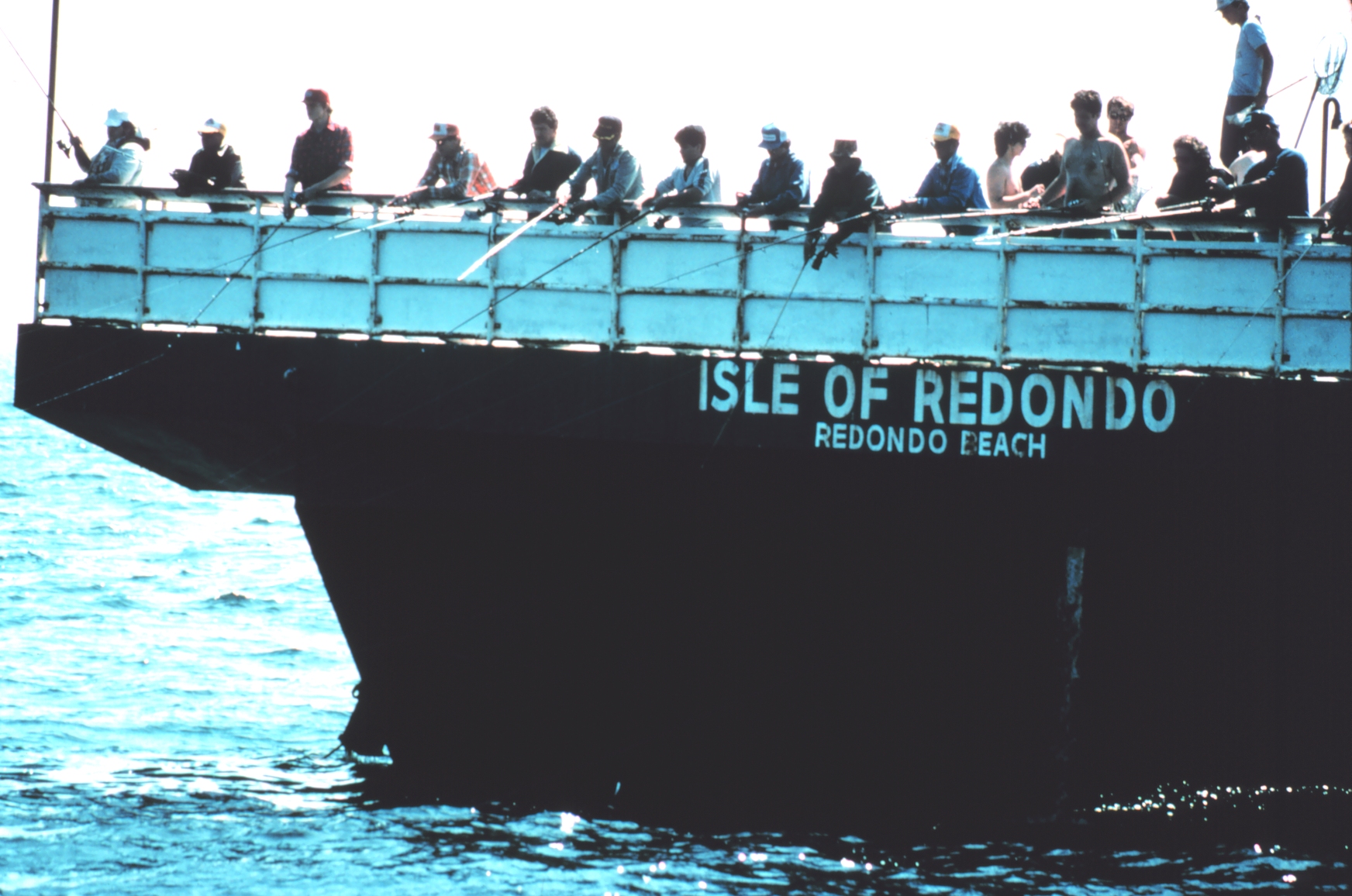
Fishing Barge — Isle of Redondo
That would be my last trip on a Redondo barge, a fact that I regret to this day (if I had only known). The Isle of Redondo ceased operation in 1998 and today the barges are merely history.
<*}}}}}}}}}>< — The most famous family in Redondo, at least as far as fishing, was perhaps the Monstad family of Redondo—Hans, Daisy, Wilbert L, Jesse, Florence, and Walter Eugene.
In 1923 Hans Monstad, patriarch of the family, began to operate a fishing business in Redondo Beach with his boat Daisy. His son Wilbur (W. L.) skippered the boat from the Municipal Pier. He soon added another boat, the Daisey II and in time the two boats became known as Big Daisey and Little Daisey.
In 1925, well aware that fishing barges were beginning to gain a stronghold in the Southern California fishing industry, Hans bought the Lahaina and soon after acquired the Fullerton, both former barkentines.
By now the Endless the pier was in dire need of repair and unsuitable for a landing. In response, Hans had his son Wilbur petition the city to build a pier. He obtained a 20-year lease with the main stipulation being that he would pay all construction costs.
1926 saw the construction of the Monstad Pier, a 300-foot-long “straight pier” that was built adjacent to, and connected with, the south leg of the new Horseshoe Pier. It was designed to be used as both a fishing pier and as a dock for the family’s “Pleasure Fishing” fleet.
Anglers had their choice of live bait boats or barges like the Big Lahaina, Fullerton, and Thomas P. Emigh. Shoreboats ran out to the barges every 20 minutes and for a mere $1.25 anglers were provided tackle and all the bait they could use. Non-fishermen could catch the daily ride to Catalina on the Enterprise—for a slightly higher $2.00. Business was good and the Monstad Pier was lengthened to 400 feet in 1927.
The height of the family fortunes was the early ‘30s when the Monstad’s had three barges in operation, six live bait boats, their own pier, and more than 40 employees. Anglers numbered as many as 2,500 in a single day.
The family would own a number of additional barges over the years including the Oceania Vance, Irene, Kohala, Star of Scotland, and the Homer. The family also would own and operate a number of smaller boats including the Hawk, New Monterey and the Tennessee.
Although the Fullerton was wrecked at Redondo Beach in May 1927 it didn’t seem to slow the family. However, family luck seemed to change in 1932 (as it did for many during the Great Depression years). The Thomas P. Emigh was driven ashore and wrecked during a 65 mph gale in April 1932. The Lahaina sunk in 1933. The Oceania Vance sunk in 1936 and the Irene sank off Redondo Beach in January 1937.
World War II started on December 7, 1941 and just two and a half weeks later, on Christmas Day 1941, the Kohala was mistakenly sunk by friendly fire—U.S. bombers.
The war years meant that no fishing from boats was allowed for a period of time and then the Star of Scotland (former Texas), while awaiting reconditioning, sprung a leak and sank in 1942.
Fishing resumed a few years later but then the Homer sank in Wilmington Harbor in 1948. Every barge that the family had owned had sunk, some from old age and neglect, some from Pacific storms, and one from the U.S. Air Corps. The business seemed at an end.
Many felt that the family business had really ended in 1939. In June of 1939 Wilbur had taken a leave from fishing and began managing the large gambling barge Monte Carlo that was anchored off of Redondo Beach. A few months later, in August, he and his brother Walter were on another gambling barge, the Texas, when it was raided. $25,000 of gambling equipment was destroyed and the ship was towed to San Pedro. Both Monstad brothers, along with several other people were arrested. Included in the list was “Russian Louie” Strauss, a killer for the L.A. Mafia. Both brothers would face court cases lasting several years. In December of 1939, apparently despondent over family fortunes, a despondent Hans Monstad committed suicide.
Through the years the family had operated the largest fleet of fishing boats out of Redondo Beach—and perhaps suffered the most misfortune. Though the family no longer runs the fishing fleet the pier that bears their name is still in existence (if somewhat changed).
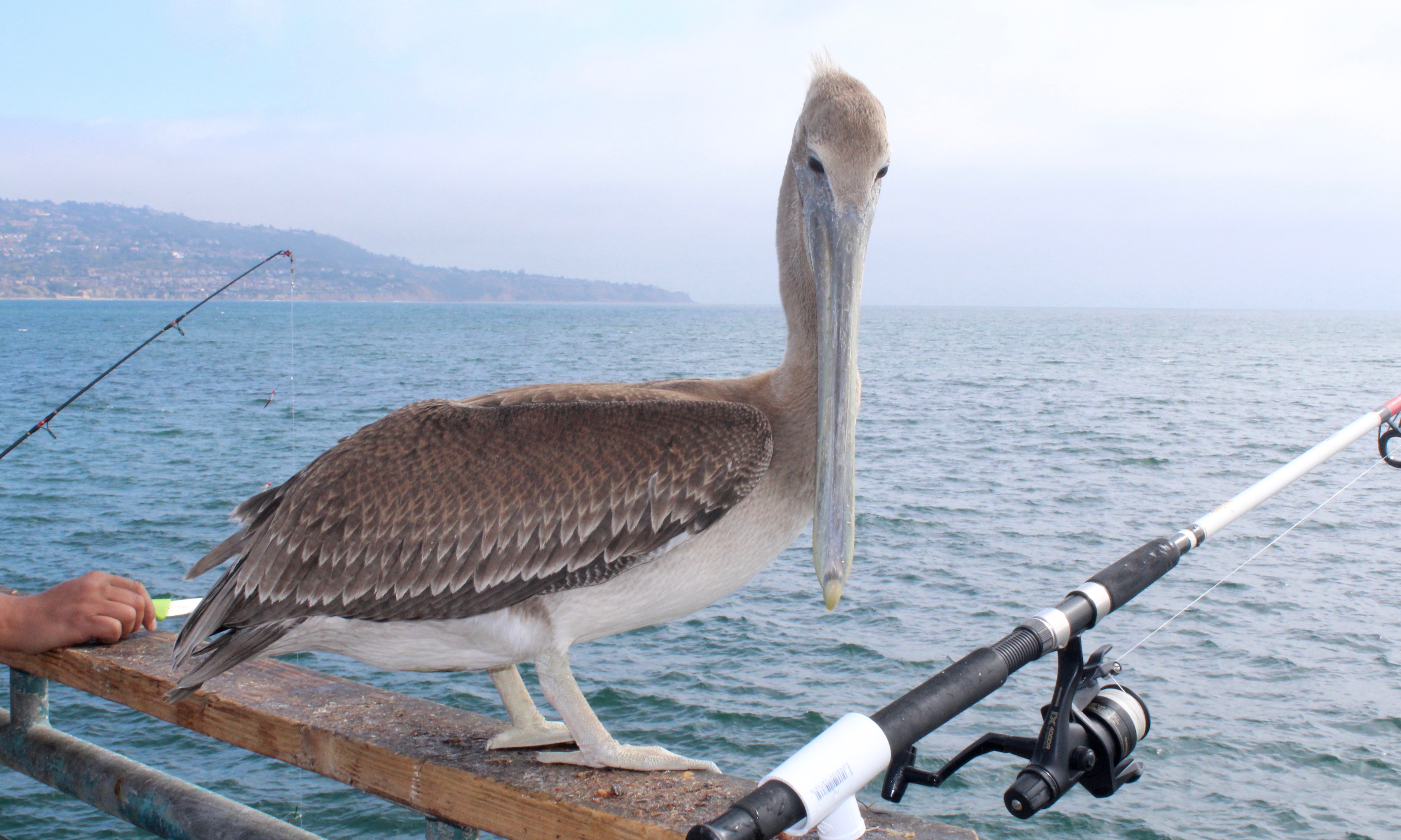
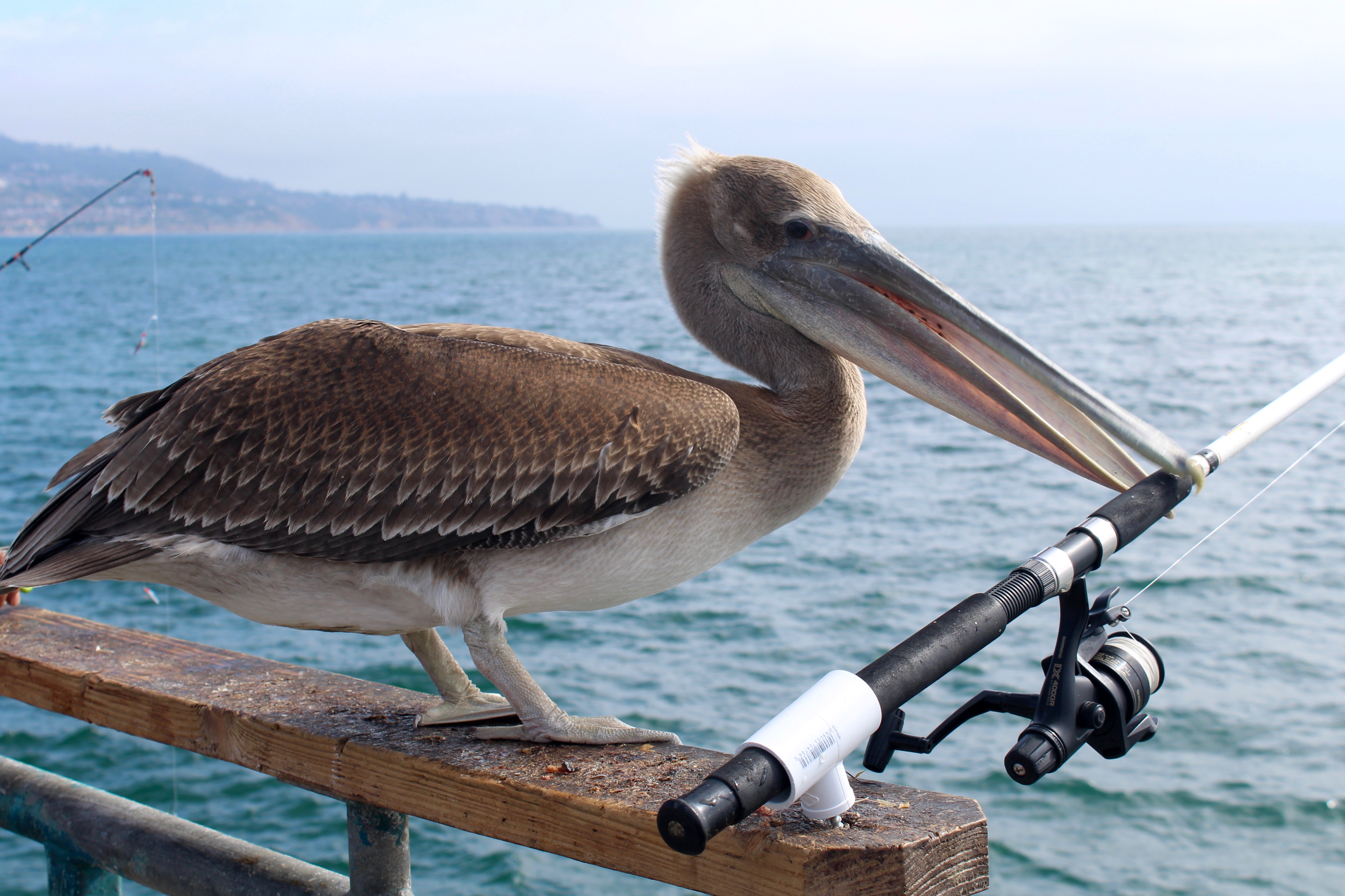
<*}}}}}}}}}>< — If you think things are tough now when it comes to fishing, at least you don’t have to keep an eye out for the trains. Not so for the unlucky fisherman in the following story.
Train Dumps Fisherman Off Pier Into Ocean — Santa Fe Accident Brings A Damage Suit
”Suit for $5,250 against the Redondo Improvement Company was commenced before Judge Gibbs of the superior court yesterday by John G. Thompson of Redondo. The plaintiff alleges that while he was fishing on Pier No. 1 a Santa Fe switching train knocked him from the pier into the ocean, at the same time inflicting a severe scalp wound upon him.
Pier No. 1, which is named in the complaint, is the property of the Santa Fe company and the one through which an engine plunged several months ago, carrying to death the fireman. A spur track is operated upon the pier, hauling cars to and from the point where steamers are loaded. The complaint alleges that on the occasion named in the complaint the train was handled carelessly.
The pier is said to be crowded daily with fishermen and Thomas alleges that on August 12, 1904, he was seated on the track when a free freight car was bumped into by the switch engine, causing the car to move forward a distance of ten feet, striking Thomas and hurling him against a timer, inflicting a scalp wound.
When Thomas was jammed against the timber he claims he was in such a position as to render it impossible for him to regain his balance, and consequently he fell into the ocean, a distance of thirty feet below.
The impact with the timer rendered him unconscious and in the complaint it is alleged he was in danger of being drowned. Since the accident, Thomas says, he has been ill a great part of the time and medical attention has cost $250.”
—Los Angeles Herald, February 14, 1906
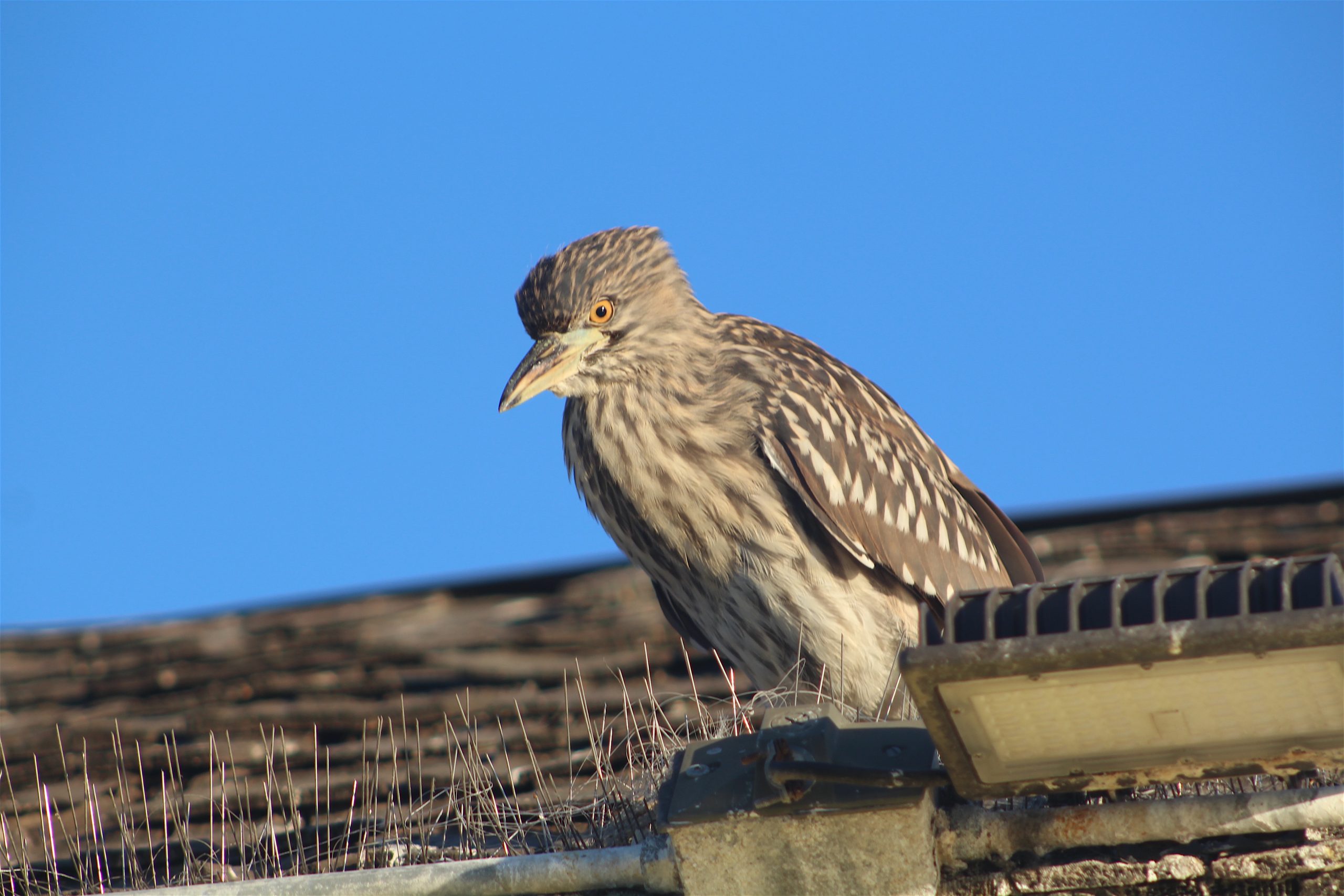
<*}}}}}}}}}>< — There are several good restaurants on the pier albeit some can be a bit pricy. Several however are moderate in price and quite good. One of the most famous (supposedly at one time the highest grossing restaurant in the U.S.) and a place I like to visit is Tony’s (aka Old Tony’s). It has a ‘70s-‘80s Rockford Files feel to it (you almost expect to see James Garner walk in wearing one of his plaid jackets), and autographed photos on the walls of the movie and T.V. stars of those years. It’s an old-fashioned kind of fish restaurant, with many menu choices reflecting an earlier era, but the food is excellent and it has provided me with delicious seafood dinners many times over the years.
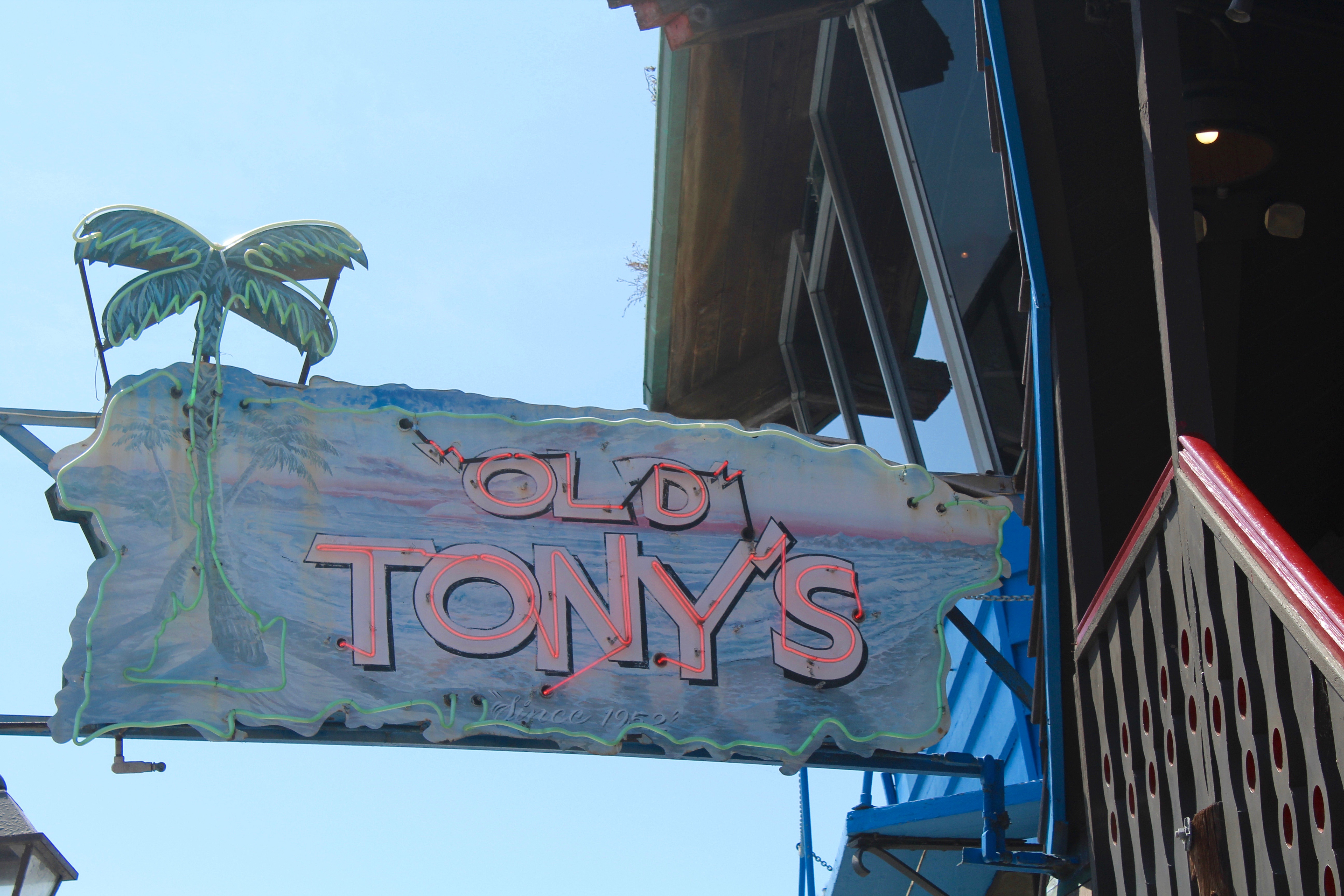
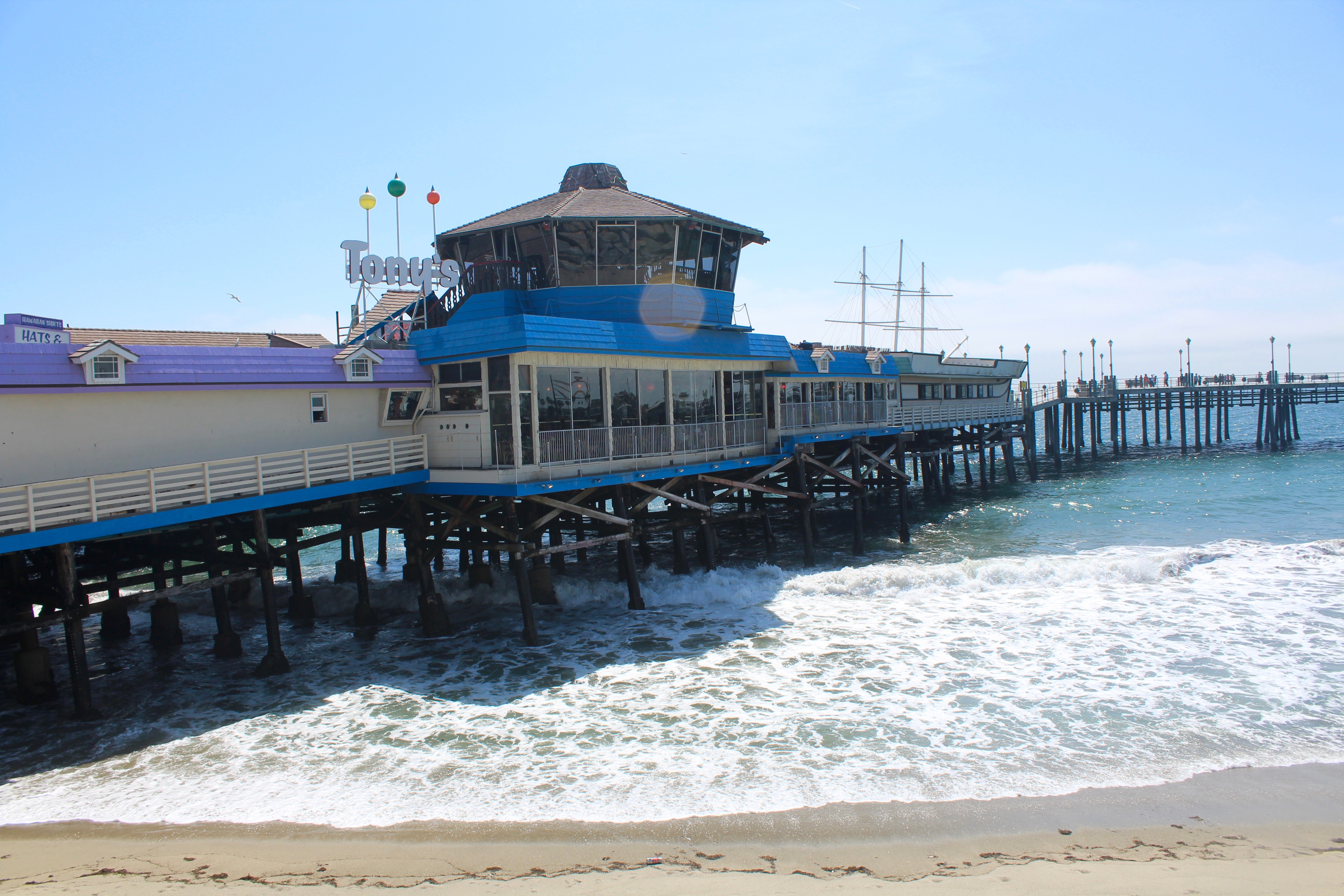
Tony’s Restaurant
If you like ethnic food you might try Gambrinus, a Russian restaurant on the International Boardwalk. They have a number of interesting dishes including belashi, a Russian-style hamburger (actually a meat-filled fried bread), a tasty beet salad, herring, hard boiled eggs, etc., and their specialty, “trout the Russian way.”
Not too far away is Naja’s, another interesting place (with reportedly the largest selections of beer in southern California). It’s basically a bar but also has good food and has received mostly good reviews, all except for one where the person wrote “Yeah sure, Naja’s is great if you like too loud cover bands jarring your sensibilities, and stupid toothless pier rats hitting on your lady every time you go for a pee.” Now that’s an interesting observation but come on, stupid and toothless? I may be stupid but I’ve still got my teeth.
Did You Know? Every pier deserves to have its own brew — right? Here it is the “Redondo Beach Pier Pale Ale” brewed by the Redondo Beach Brewing Company. Unfortunately, on-line beer connoisseurs only seem to give it about a 3 out of 5 rating, not bad but also not that great.
Did You Know? The Redondo Beach Pier was used as a primary filming location for the TV series, The O.C., as a location for the TV series, Riptide from 1984–1986, as a location in Big Momma’s House 2, and as a location in the remake of the show 90210 with Trevor Donovan.
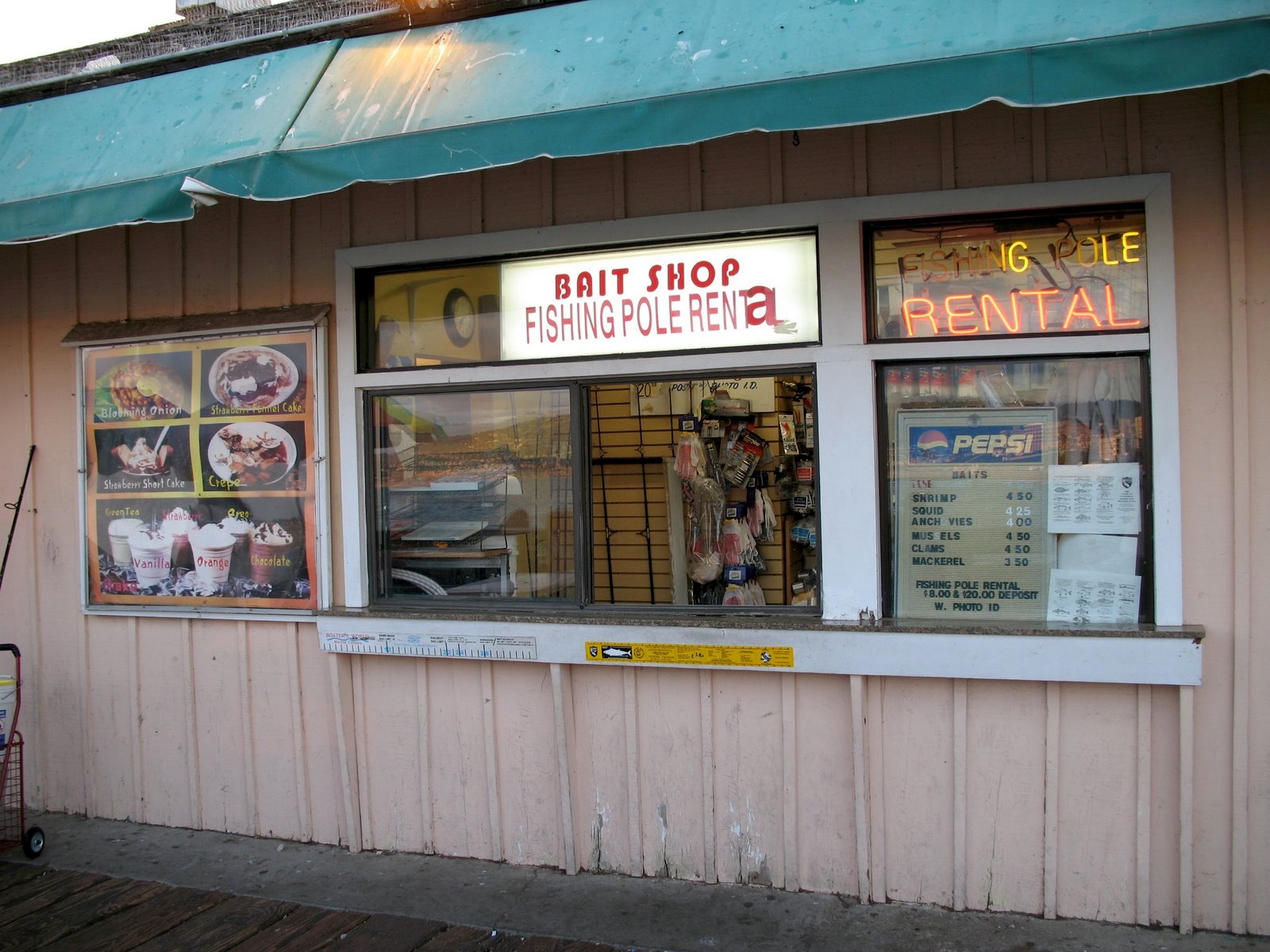
Redondo Beach Municipal Pier Facts
Hours: Open 24 hours.
Facilities: Lights, benches, restrooms, fish cleaning station, snack bars, and a bait and tackle shop are all located on the pier. There is a huge parking lot with rates of $.50 an hour with a $2 maximum. At last count 32 different concessions were located on the pier.
Handicapped facilities: No handicapped parking. The Monstad Pier is wheelchair accessible with a fishing platform at the seaward end. The railing is 44 inches high and there are several handicapped accessible restrooms on the pier. Not posted for handicapped.
Location: 33.83888377189932N. Latitude, 118.39205145835876 W. Longitude.
How To Get There: From the Pacific Coast Highway, take Torrance Blvd. west to the foot of the pier and the parking lot.
Management: City of Redondo Beach/Redondo Beach Harbor Department.
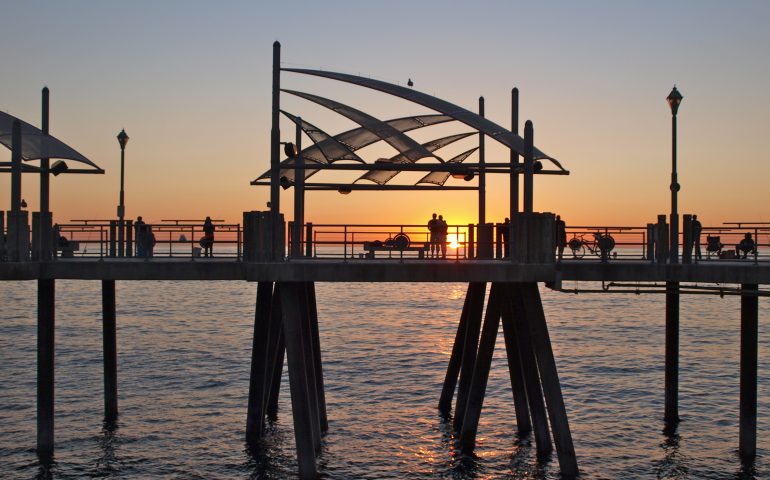
Who thought of making peir bridge drop fishing net
Now, how can we stop fishermen from OVERHEAD CASTING? YES, there are the signs, but on my, almost daily
Walks, I see people violating the overcasting rule
I wish I knew the answer to that. Been trying to teach people not to do that for over 30 years but there’s still a lot of knuckleheads out there.
Ken
The Bounty , the Polynesia. Horse shoe. Beach. Diving. For. Change.
That Yellowtail story is so crazy! So many unlikely things happening at once!
Unfortunately sea lions stealing fish is not that uncommon and, given the way fish are slowed down during a fight, they are prime targets for sea lions.
I was there a few days ago. Is it always so busy with anglers?
I had fun, got about 7 mackerels and 4 bonito (I think).
New to RB. Can I catch crab with a crab net at the pier? I believe there are regulations with the size of crab I could keep which I will abide to. I just don’t want to get in trouble or piss people off around me.